
The AMD Ryzen 9 7950X3D Review: AMD’s Fastest Gaming Processor
2023-02-27Last year, AMD released its Ryzen 7 5800X3D to the market with 96 MB of L3 V-Cache. The consumer implementation of AMD’s then-new 3D stacked V-Cache technology, which allowed for greatly expanding the total L3 cache available on a CPU, the 5800X3D was primarily aimed at the gaming market, where the additional 64MB of L3 cache could be uniquely useful to improving performance in CPU-bound gaming workloads. While hit-and-miss depending on the specific game at hand, in the right games and the right scenarios, the additional cache could provide a performance boost that even the highest-clocked CPUs couldn’t match.
AMD’s initial implementations of V-Cache in the 5800X3D and its server counterpart, Milan-X, were just the tip of the iceberg for the company. Though the benefits of this stacked cache manufacturing strategy were limited with the initial generation of products, AMD’s eye has been on the long game: V-Cache is forward-looking design that will pay off with bigger dividends for AMD over time, as they’ll eventually be able to produce the V-Cache dies using older and cheaper manufacturing processes, optimizing their manufacturing costs while still being able to offer what is by CPU standards an absurd amount of L3 cache. Ultimately, this multi-generational strategy for V-Cache was laid out in greater detail in AMD’s 2023-2024 desktop CPU roadmap, which outlined their intention to bring it to AMD’s recently launched Ryzen 7000 series chips.
That brings us to today, and the impending launch of AMD’s second generation of V-Cache equipped consumer chips, the Ryzen 7000X3D family. Tomorrow morning AMD will be releasing a pair of their latest-generation Ryzen 7000 chips with the extra cache stacked on, including the Ryzen 9 7950X3D (16C/32T) and the Ryzen 7 7900X3D (12C/24T). Both chips build upon their X-series predecessors by adding a further 64MB of L3 cache, bringing them to an impressive total of 128 MB of L3 cache.
Meanwhile, a third SKU, the AMD Ryzen 7 7800X3D, is in the works for April 6th. That part will offer 8 CPU cores and 96 MB of L3 cache, making it the most direct successor to the Ryzen 7 5800X3D.
Ultimately, all three chips will serve to update AMD’s product stack by combining the strengths of the Zen 4 CPU architecture with the performance benefits of the extra L3 cache, which during the overlapping period of the last several months, has been split between the Ryzen 5000 and Ryzen 7000 families. In short, PC gamers will finally be able to have their cake and eat it too, gaining access to AMD’s Zen 4 microarchitecture and its myriad of benefits (higher IPC, higher clockspeeds, DDR5, PCIe 5) with a nice helping of additional L3 cache slathered on top.
From that stack, today we’re reviewing the new flagship Ryzen 9 7950X3D. The 7950X3D offers 16 Zen 4 cores spread over two CCDs (8C/16T per CCD). AMD had to elect one of the CCDs to stack the additional L3 cache onto, resulting in a new-to-AMD heterogeneous CPU design, but they do have some special sauce as a garnish to make it work. We aim to determine if the Ryzen 9 7950X3D is the chip gamers have been yearning for and how it stacks up against other Ryzen 7000 chips (and Intel’s 13th Gen) in our test suite.
Up until now, we’ve had a wave of Ryzen 7000 series SKUs launch, including the flagship Ryzen 9 7950X and other X-series SKUs such as the Ryzen 9 7900X, Ryzen 7 7700X, and Ryzen 5 7600X, as well as their 65 W SKUs which have filled out the product stack nicely. Offering different configurations of core counts, frequencies, and ultimately price, the Ryzen 7000 stack is loaded with chips for users of all levels.
AMD’s 3D V-Cache packaging slide (Zen 3): AMD uses the same method for Zen 4
These newest chips from AMD, in turn, expand the Ryzen 7000 stack further by adding a trio of parts incorporating AMD’s 3D V-Cache technology. The basic idea behind 3D V-Cache is to stack additional cache memory on top of the existing processor die. The cache memory is then connected to the die using through-silicon vias (TSVs), which are vertical interconnects that pass through the silicon substrate. This allows for a much larger amount of L3 cache memory to be added to the processor without requiring that AMD mint a separate, larger CCD.
The 3D V-Cache packaging process worked well with the Ryzen 7 5800X3D, and we did see gains in frame rates across some of the games we tested; some games are memory/cache-bound, and thus can make good use of the additional L3 cache for a performance boost, while other games are unfazed by the additional cache as they are more outright compute-bound. Ultimately, the benefits of the additional cache do not make for a one-size-fits-all situation, as it varies from title to title, sometimes significantly so. As things stand, there unfortunately isn’t anything quite like a whitelist of games that can benefit from the additional cache, which means the best guidance we can offer is that gamers will want to take the time to do a little extra research to see if the specific games they care about are any faster on these X3D chips.
| AMD Ryzen 7000 Series Line-Up (as of 02/27) | ||||||||
| AnandTech | Cores Threads |
Base Freq |
Turbo Freq |
Memory Support |
L3 Cache |
TDP | PPT | Price (Street) |
| Ryzen 9 7950X3D | 16C / 32T | 4.2 GHz | 5.7 GHz | DDR5-5200 | 128 MB | 120W | 162W | $699 |
| Ryzen 9 7950X | 16C / 32T | 4.5 GHz | 5.7 GHz | DDR5-5200 | 64 MB | 170W | 230W | $589 |
| Ryzen 9 7900X3D | 12C / 24T | 4.4 GHz | 5.6 GHz | DDR5-5200 | 128 MB | 120W | 162W | $599 |
| Ryzen 9 7900X | 12C / 24T | 4.7 GHz | 5.6 GHz | DDR5-5200 | 64 MB | 170W | 230W | $448 |
| Ryzen 9 7900 | 12C / 24T | 3.6 GHz | 5.4 GHz | DDR5-5200 | 64 MB | 65W | 88W | $460 |
| Ryzen 7 7800X3D | 8C / 16T | 4.2 GHz | 5.0 GHz | DDR5-5200 | 96 MB | 120W | 162W | $449 |
| Ryzen 7 7700X | 8C / 16T | 4.5 GHz | 5.4 GHz | DDR5-5200 | 32 MB | 105W | 142W | $341 |
| Ryzen 7 7700 | 8C / 16T | 3.6 GHz | 5.3 GHz | DDR5-5200 | 32 MB | 65W | 88W | $329 |
| Ryzen 5 7600X | 6C / 12T | 4.7 GHz | 5.3 GHz | DDR5-5200 | 32 MB | 105W | 142W | $241 |
| Ryzen 5 7600 | 6C / 12T | 3.8 GHz | 5.1 GHz | DDR5-5200 | 32 MB | 65W | 88W | $230 |
Looking at the main specifications of the Ryzen 9 7950X3D, it has 16 Zen 4 CPUs cores and operates at a TDP rating of 120 W; this is some 50 W lower than the regular Ryzen 9 7950X. According to AMD, the more relevant Package Power Tracking (PPT) rating is 1.35x the TDP, which puts the socket power output at up to 162 W. The Ryzen 9 7950X3D also shares the same turbo frequency as the Ryzen 9 7950X, which is 5.7 GHz, but AMD has lowered the base frequency by 300 MHz, making it 4.2 GHz on the 7950X3D. Memory support remains unchanged from the rest of the Ryzen 7000 family, with JEDEC-compliant speeds topping out at DDR5-5200, while overclocking (AMD EXPO, etc) can take it over DDR5-6000.
Although we’re only reviewing the Ryzen 9 7950X3D today, the two other Ryzen 7000 X3D SKUs are worth mentioning. The other SKU launching today is the Ryzen 9 7900X3D, a 12-core/24-thread part with the same 128 MB of 3D stacked L3 V-Cache. It also features a 120 W TDP/162 W PPT, and has the same 5.6 GHz turbo clock speed as the Ryzen 9 7900X. Like the differences between the Ryzen 9 7950X3D and 7950X, the base core frequency is lower on the Ryzen 9 7900X3D than its counterpart, with a base frequency of 4.4 GHz, a 200 MHz drop over the Ryzen 9 7900X.
The third SKU with 3D V-Cache is the Ryzen 7 7800X3D, which isn’t available until the 6th of April, but it’s still a very interesting part. Not only is it the only chip to use the 7800 model number, but it’s very similar in specifications to the original Ryzen 7 5800X3D, a very successful SKU that is currently (still) the number 5 best-selling CPU on Amazon at the time of writing. Like the Ryzen 7 5800X3D, the soon-to-be-released Ryzen 7 7800X3D shares a turbo frequency of 5 GHz. The Ryzen 7 7800X3D has a 4.2 GHz base frequency, but it benefits from AMD’s latest Zen 4 architecture, built upon TSMC’s N5 5 nm manufacturing process. As we saw in our Ryzen 9 7950X and Ryzen 5 7600X review, AMD has boosted performance per watt efficiency and improved IPC performance nicely.
A Tale of Two CCDs: One with 3D V-Cache, One Without
The Ryzen 7000 and 5000 families are built upon a chiplet-based design, with top-end chips such as the Ryzen 9 7950X featuring two core complex dies (CCD) as well as a singular I/O die (IOD) Chips in the family with lower core counts, such as the Ryzen 7 and 5 families, typically bring this down to one active CCD (and potentially one fused-off CCD if the chip was salvaged).
With their first-generation Ryzen 7 5800X3D, AMD avoided any complexities involving mixing V-Cache with their multi-CCD designs by only ever producing X3D parts with a single CCD. However for this generation, AMD is taking the next step by making multi-CCD X3D parts available – and they aren’t putting V-Cache on both CCDs.
This quandary over using two CCDs with V-Cache has raised many questions with users since AMD initially revealed their new Ryzen 7000X3D parts. The long and short of matters is that for this generation, AMD has taken steps to have the best of both worlds – to have a V-Cache-equipped CCD while also having another, unencumbered CCD in order to offer the highest compute performance.
Touching on the design of the Ryzen 9 7950X3D, AMD is employing an asymmetric chiplet design, where one of the CCDs is a vanilla Zen 4 CCD, and the other is a Zen 4 CCD with 64 MB of V-Cache stacked on. This means that the Ryzen 9 7950X3D has one CCD with 96 MB of L3 cache, while the second “vanilla” CCD still has the usual 32 MB available. AMD’s Infinity Fabric Interconnect keeps everything flowing, which connects both CCDs to the centralized IOD in a die-to-die connect flow.
Notably, just as the two CCDs are unequal in cache, they’re also unequal in peak clockspeeds. Attaching a V-Cache die to a CCD limits the highest clockspeeds it can attain, capping it at around 5.25GHz. Thus, compared to the 5.7GHz max clockspeed of a plain Zen 4 CCD (as used on the 7950X/7950X3D), this represents a roughly 8% frequency handicap for adding V-Cache. Which is why AMD is including both types of CCDs on their Ryzen 9 7000X3D parts, ensuring that applications have access to whatever type of CCD better fits their processing needs.
Ultimately, AMD states that having one CCD with V-Cache and one standard CCD provides the best balance for maximizing performance in both gaming workloads and general heavy workload compute tasks. Applications and games that can benefit from the larger pool of L3 cache can be loaded up on to the V-Cache CCD, while everything else is loaded up on the standard CCD (and growing out to the second CCD as needed).
Drivers & OS Scheduling: PPM Provisioning & V-Cache Performance Optimizer
This additional layer of complexity means that, for the first time on a consumer AMD platform, AMD’s CPUs are now heterogeneous. Depending on which CCD they’re on, the CPU cores within a 7950X3D are dissimilar, and that’s something that needs to be taken into account when scheduling which CPU core/CCD a thread will go on. To that end, AMD has developed a pair of Windows drivers for the 7000X3D series to help the Windows scheduler more intelligently place threads on the best CCD for the task.
Under the hood, AMD is essentially hooking into Windows’ Game Mode (and Mixed Reality Mode) to let the OS determine when a game is active, and then use that hint to change how Windows thread scheduling works. The resulting layers of BIOS features, Xbox Game Bar software (which controls Game Mode), and AMD’s drivers add up to a complete control mechanism for allocating work on the 7950X3D and 7900X3D.
Diving into AMD’s software stack, the first of AMD’s drivers is the AMD PPM Provisioning Driver. This comes included within the 5.01.03.005 version (or newer) of AMD’s chipset driver. This driver steers threads by parking what AMD determines is the least performant CCD, leaving only the more performant CCD initially active. This keeps all of the threads for a game on the same CCD, reducing (if not eliminating) the need to reach across the IOD to access the L3 cache on the other CCD, and thus improving the cache hit rate and resulting performance.
Technically, the PPM driver can park either CCD. But in practice it’s going to virtually always be the vanilla CCD, pushing games on to the V-Cache CCD. Though should a game ask for more CPU cores (and technically, threads) than a single CCD can provide, then the PPM will allow the other CCD to go active. Parking the CCD doesn’t prevent its use – so all 16 CPU cores are available – it just discourages using more than 1 CCD (8 cores) when at all possible.
Meanwhile, users can manually override this feature in their motherboard’s firmware under the AMD CBS section of the Ryzen overclocking settings. While each motherboard vendor’s firmware is different in design, features, and styling, changing the setting to auto can be switched to either ‘cache’ for workloads or games benefiting from the 3D V-Cache, or set it to ‘frequency’ in which it will allow the faster CCD to do the heavy lifting.
Moving on, the second of AMD’s new X3D drivers is the AMD 3D V-Cache Performance Optimizer Driver. Again, this comes bundled into the chipset driver, and it operates as the counterpart to the PPM driver, changing how Windows ranks the performance of the various CPU cores.
Typically, Windows will rank CPU cores by clockspeeds, which is usually the correct way to go for physically homogenous CPU cores. Especially in the case of things like favored/preferred cores and “prime” CPU cores (e.g. Windows on Arm), putting heavy workloads on the fastest CPU core will net you the best performance. However having heterogeneous cores with different amounts of L3 cache changes this calculus – it’s possible (and even likely) for a slower CPU core to be faster thanks to its access to a larger local L3 cache pool.

The AMD 3D V-Cache Performance Optimizer Driver working in the background
The net result, then, is that the 3D V-Cache Performance Optimizer Driver will change Windows’ performance rankings when Game Mode is active so that Windows will try to use the CPU cores on the V-Cache CCD first. Coupled with the PPM driver, these two techniques are how AMD will try to ensure that games and their threads are sent to the V-Cache CCD first, while everything else continues to favor the traditional, higher-clocked CCD.

Ryzen 9 7950X3D automatically detecting Total War: Warhammer 3 as a game in Xbox Game Bar
Finally it’s worth highlighting that Game Mode within Windows 11/10 must be enabled for the AMD PPM and Performance Optimizer drivers to work seamlessly. AMD states that the Ryzen 7000X3D chips and their associated software stack will work under both Windows 10 (1903 or later) and Windows 11 (21H2 or later). But AMD pretty strongly recommends users go with Windows 11, as if nothing else, there are some potential cosmetic reporting bugs that remain on Windows 10 when Virtualization Based Security (VBS) is enabled. Meanwhile VBS is an outright requirement on Windows 11.
Ryzen 9 7950X3D: No Unlocked Multiplier, But Supports Curve Optimizer, Precision Boost Overdrive, and AMD EXPO Memory
AMD, with its Ryzen 7000 65 W processors, showed impressive power-to-performance efficiency compared with its existing Ryzen 7000 chips. AMD is looking to show off its capabilities further while drawing less power. Of course,
Unlike AMD’s regular X-series SKUs, The Ryzen 9 7950X3D does not have an unlocked multiplier; meaning manually overclocking the cores is disabled. But the chip does still benefit from some of AMD’s overclocking technology. While the Ryzen 7 5800X3D was limited to memory overclocking, the Ryzen 9 7950X3D has AMD’s Curve Optimizer and Precision Boost Overdrive enabled. The Curve Optimizer allows users an easy one-click option to at least, in theory, deliver a boost to core performance. This can be enabled in AMD’s Ryzen Master overclocking utility, while AMD’s Precision Boost Overdrive can also be enabled similarly.
Memory overclocking is also still available on these X3D SKUs. This goes for both manual overclocking, and using EXPO memory profiles on memory kits that come with those overclocking profiles. There are numerous EXPO-enabled kits on the market right now, especially from Corsair and G.Skill. And even XMP kits work to an extent, though their timings may not be ideal for AMD’s Ryzen 7000 series processors.
For a more detailed analysis of our AMD Ryzen 7000 (Zen 4) coverage, here are a few links with a more in-depth look at the Zen 4 core architecture, as well as AMD’s AM5 platform:
- AMD Zen 4 Ryzen 9 7950X and Ryzen 5 7600X Review: Retaking The High-End
- AMD’s Desktop CPU Roadmap: 2024 Brings Zen 5-based “Granite Ridge”
- AM5 Chipsets: X670 and B650, Built by ASMedia
- Ryzen 7000 I/O Die: TSMC & Integrated Graphics at Last
From a marketing point of view, the AMD Ryzen 9 7950X3D is primarily aimed at gamers, particularly those who play games that can make good use of the additional L3 cache. When we reviewed the Ryzen 7 5800X3D, we found it lacking a little in compute tasks when directly compared to the regular Ryzen 7 5800X due to lower core frequencies and a lock on turbo frequencies. The flip side is that we saw some of the benefits of AMD’s 3D V-Cache stacking technology in gaming, making it a purchase better suited for gamers in particular, rather than the broader performance enthusiast market.
AMD is looking to change that perception somewhat with its Ryzen 7000X3D SKUs, thanks to higher overall clockspeeds and the use of heterogeneous (asymmetrical) CPU cores. Thus we expect less of a hit on compute performance with these due to still combining decent levels of frequencies, and specifications, albeit, at a lower PPT power rating of 162 W.
From a pricing point of view, AMD has priced the Ryzen 9 7950X3D at what was the original MSRP of the Ryzen 9 7950X: $699. This makes the flagship X3D chip around $110 more expensive than the 7950X, which these days can be snagged for $589. For the other chips, the Ryzen 9 7900X3D ($599) is $150 more expensive than the Ryzen 9 7900X (currently $449), while the Ryzen 7 7800X3D will cost $449 when it releases in April.

The Ryzen 9 7950X3D in retail packaging: Ready to cook up
Finally, taking a look at the competitive landscape, AMD is aiming the Ryzen 9 7950X3D more at the Core i9-13900K in gaming than its Ryzen 9 7950X counterpart. So it’s time to put it on our test bench, put it through its paces in our test suite, and see how well the Ryzen 9 7950X3D fares against the competition. Compute performance enthusiasts will likely find that the Ryzen 9 7950X is still an overall better chip; whereas the Ryzen 9 7950X3D is looking to leverage its 128 MB of L3 cache in games to make it the best gaming chip on the market. Let’s see what we’re dealing with.
The Current CPU Test Suite
For our AMD Ryzen 9 7950X3D testing, we are using the following test system:
| AMD Ryzen 7000 Series System (DDR5) | |
| CPU | Ryzen 9 7950X3D ($699) 16 Cores, 32 Threads 120 W TDP |
| Motherboard | GIGABYTE X670E Aorus Master (BIOS 813b) |
| Memory | G.Skill Trident Z5 Neo 2×16 GB DDR5-5200 CL44 |
| Cooling | EK-AIO Elite 360 D-RGB 360 mm AIO |
| Storage | SK Hynix 2TB Platinum P41 PCIe 4.0 x4 NMve |
| Power Supply | Corsair HX1000 |
| GPUs | AMD Radeon RX 6950 XT, Driver 31.0.12019 |
| Operating Systems | Windows 11 22H2 |
Our updated CPU suite for 2023 includes various benchmarks, tests, and workloads designed to show variance in performance between different processors and architectures. These include UL’s latest Procyon suite with both office and photo editing workloads simulated to measure performance in these tasks, CineBench R23, Dwarf Fortress, Blender 3.3, and C-Ray 1.1.
Meanwhile, we’ve also carried over some older (but still relevant/enlightening) benchmarks from our CPU 2021 suite. This includes benchmarks such as Dwarf Fortress, Factorio, and Dr. Ian Cutress’s 3DPMv2 benchmark.
We have also updated our pool of games going forward into 2023 and beyond, including the latest F1 2022 racing game, the CPU-intensive RTS Total War: Warhammer 3, and the popular Hitman 3.
Our previous sets of ‘office’ benchmarks have often been a mix of science and synthetics, so this time we wanted to keep our office section purely on real-world performance. We’ve also incorporated our power testing into this section too.
The biggest update to our Office-focused tests for 2023 and beyond include UL’s Procyon software, which is the successor to PCMark. Procyon benchmarks office performance using Microsoft Office applications, as well as Adobe’s Photoshop/Lightroom photo editing software, and Adobe Premier Pro’s video editing capabilities. Due to issues with UL Procyon and the video editing test, we haven’t been able to properly run these, but once we identify a fix with UL, we will re-test each chip.
We are using DDR5 memory on the Ryzen 9 7950X3D and the other Ryzen 7000 series we’ve tested. This also includes Intel’s 13th and 12th Gen processors. We tested the aforementioned platforms with the following settings:
- DDR5-5600B CL46 – Intel 13th Gen
- DDR5-5200 CL44 – Ryzen 7000
- DDR5-4800 (B) CL40 – Intel 12th Gen
All other CPUs such as Ryzen 5000 and 3000 were tested at the relevant JEDEC settings as per the processor’s individual memory support with DDR4.
Power
The nature of reporting processor power consumption has become, in part, a bit of a nightmare. Historically the peak power consumption of a processor, as purchased, is given by its Thermal Design Power (TDP, or PL1). For many markets, such as embedded processors, that value of TDP still signifies the peak power consumption. For the processors we test at AnandTech, either desktop, notebook, or enterprise, this is not always the case.
Modern high-performance processors implement a feature called Turbo. This allows, usually for a limited time, a processor to go beyond its rated frequency. Exactly how far the processor goes depends on a few factors, such as the Turbo Power Limit (PL2), whether the peak frequency is hard coded, the thermals, and the power delivery. Turbo can sometimes be very aggressive, allowing power values 2.5x above the rated TDP.
AMD and Intel have different definitions for TDP that are, broadly speaking, applied the same. The difference comes from turbo modes, turbo limits, turbo budgets, and how the processors manage that power balance. These topics are 10000-12000 word articles in their own right, and we’ve got a few articles worth reading on the topic.
- Why Intel Processors Draw More Power Than Expected: TDP and Turbo Explained
- Talking TDP, Turbo and Overclocking: An Interview with Intel Fellow Guy Therien
- Reaching for Turbo: Aligning Perception with AMD’s Frequency Metrics
- Intel’s TDP Shenanigans Hurts Everyone

Given that the Ryzen 9 7950X3D has a lower TDP and PPT rating than the Ryzen 9 7950X, it pulls less power. We observed a peak power output of 144.53 W on the 7950X3D, compared to 221.87 W on the 7950X. Talking figures, the Ryzen 7950X3D is pulling around 65% of the power of the 7950X3D, which is understandable given the power limitations due to the CCX laden with AMD’s 3D V-Cache packaging.
Looking at the power consumption of the Ryzen 9 7950X3D in closer detail, we can see that it delivered a consistent load of between 140 and 144 W in our Prime95 sustained power test. This is around 18 Watts lower than the official Package Power Tracking (PPT) level AMD has set at 162 W. However, it operates higher than the TDP of 120 W, which is to be expected. The TDP and PPT ratings are different as the TDP is the base power the CPU should be drawing, while the PPT (socket), set at 162 W, is the maximum the processor can draw as a maximum under full load.
Office/Web
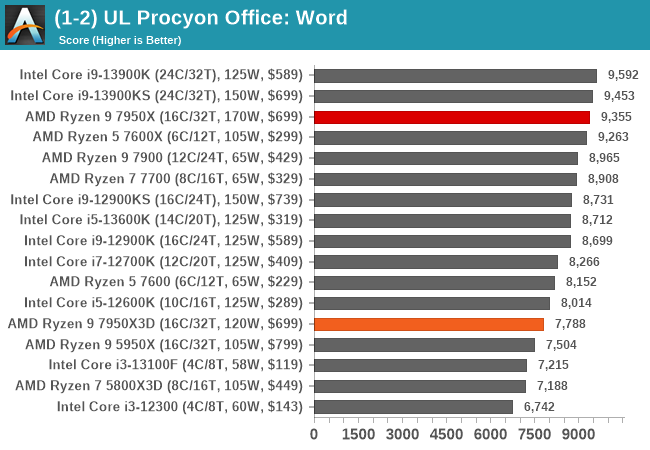

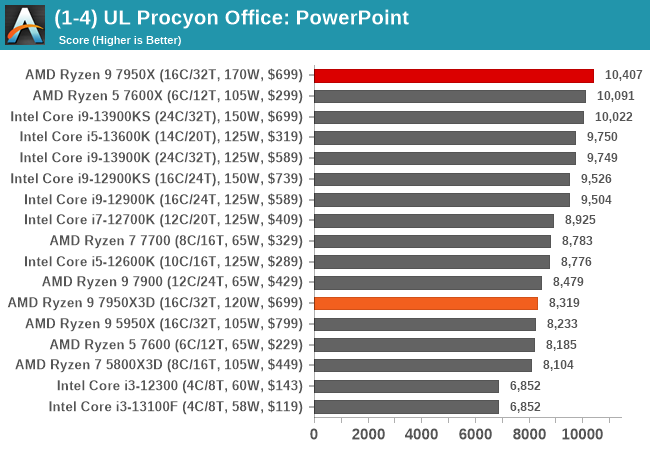
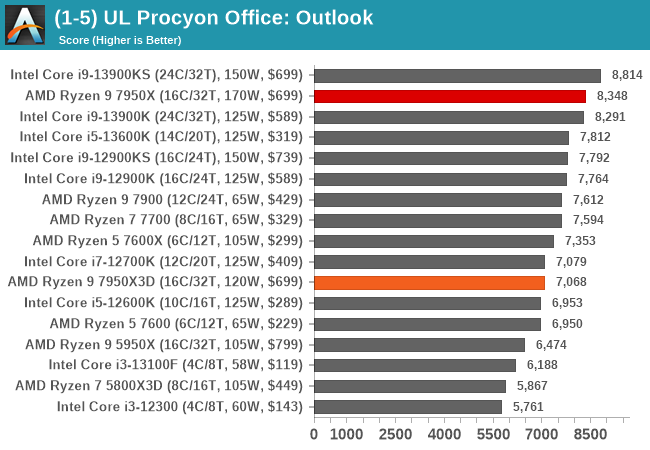
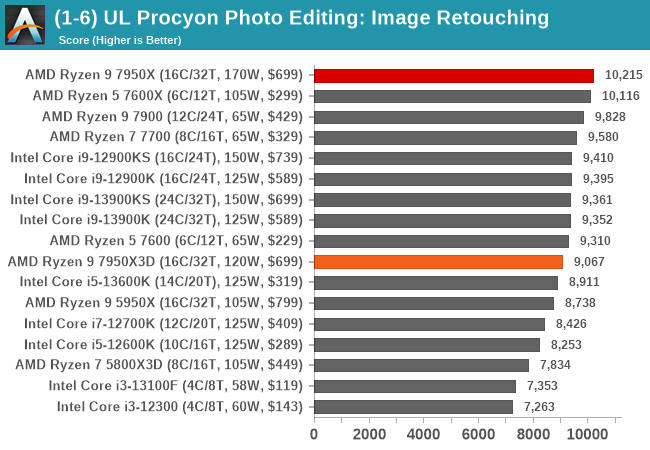


In our office-based testing, the Ryzen 9 7950X3D performs a little worse than the 7950X, but this is to be expected given the differences in TDP, PPT, and the overall power envelope. Still, the 7950X3D performs well and is more than suitable for office and web-based tasks.
Our Science section covers all the tests that typically resemble more scientific-based workloads and instruction sets. For our 2023 CPU suite, we’ve also added SciMark 2.0 which measures numerical kernels and various computational routines found in numeric coding.
We are using DDR5 memory on the Ryzen 9 7950X3D and the other Ryzen 7000 series we’ve tested. This also includes Intel’s 13th and 12th Gen processors. We tested the aforementioned platforms with the following settings:
- DDR5-5600B CL46 – Intel 13th Gen
- DDR5-5200 CL44 – Ryzen 7000
- DDR5-4800 (B) CL40 – Intel 12th Gen
All other CPUs such as Ryzen 5000 and 3000 were tested at the relevant JEDEC settings as per the processor’s individual memory support with DDR4.
Science
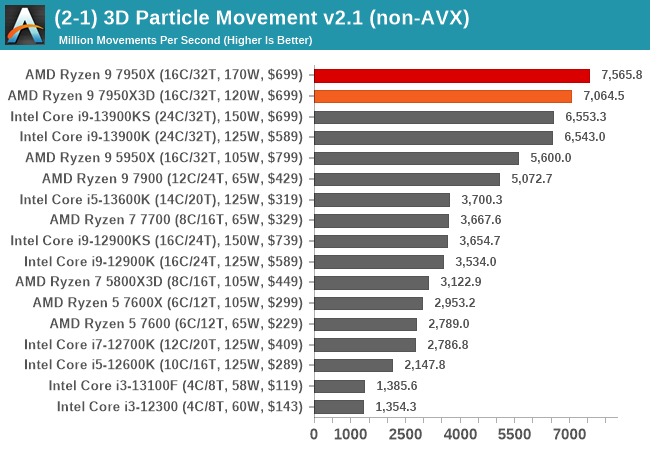
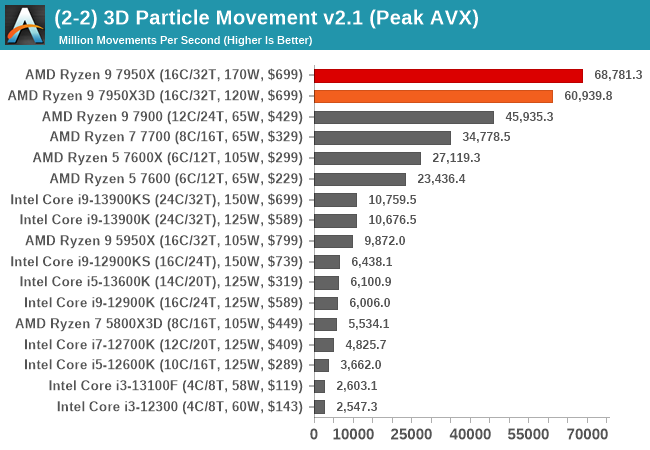
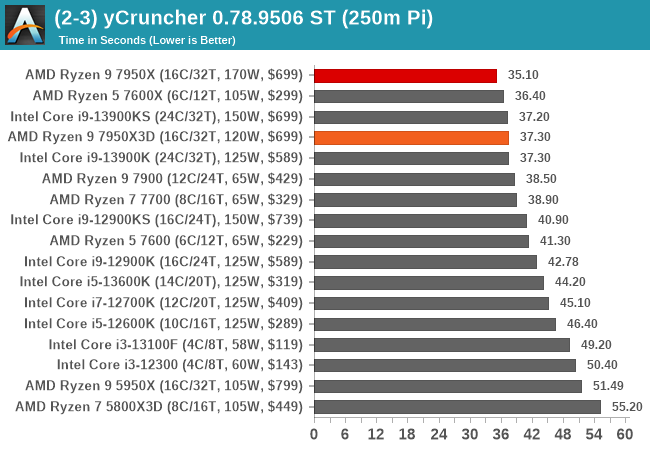


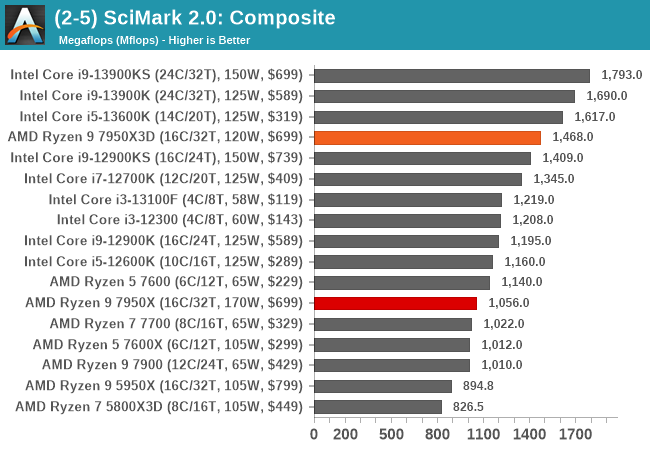

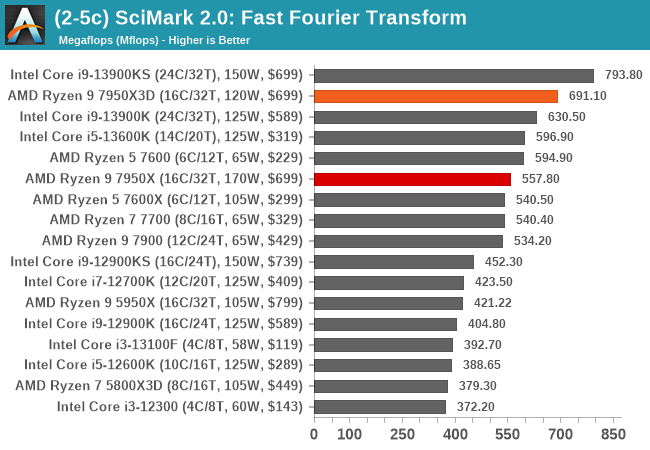
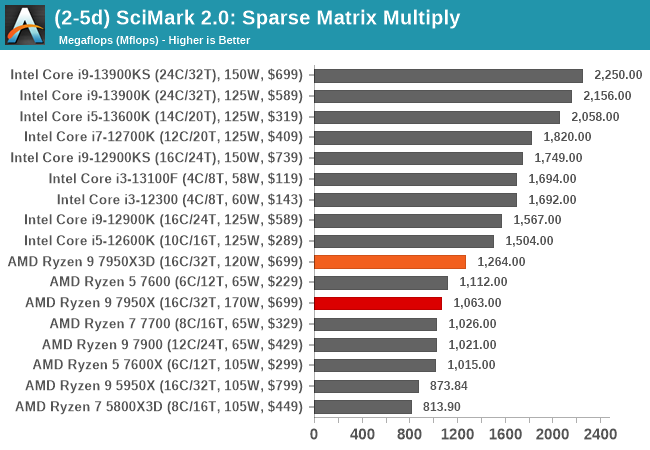
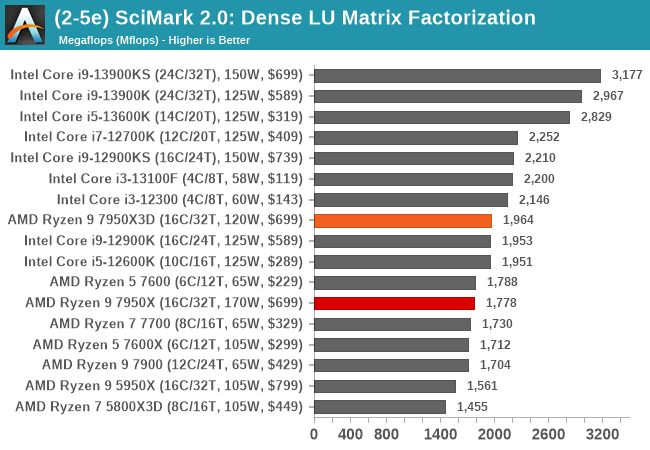


Our science tests focus on scientific-level workloads, and from the above figures, the Ryzen 9 7950X3D performs respectably, as we would expect. The additional 64 MB (128 MB in total across both CCXs) to one of the CCXs does actually provide some benefit in these types of workloads, at least compared directly to the 7950X.
Simulation and Science have a lot of overlap in the benchmarking world. The benchmarks that fall under Science have a distinct use for the data they output – in our Simulation section, these act more like synthetics but at some level are still trying to simulate a given environment.
In the encrypt/decrypt scenario, how data is transferred and by what mechanism is pertinent to on-the-fly encryption of sensitive data – a process by which more modern devices are leaning to for software security.
We are using DDR5 memory on the Ryzen 9 7950X3D and the other Ryzen 7000 series we’ve tested. This also includes Intel’s 13th and 12th Gen processors. We tested the aforementioned platforms with the following settings:
- DDR5-5600B CL46 – Intel 13th Gen
- DDR5-5200 CL44 – Ryzen 7000
- DDR5-4800 (B) CL40 – Intel 12th Gen
All other CPUs such as Ryzen 5000 and 3000 were tested at the relevant JEDEC settings as per the processor’s individual memory support with DDR4.
Simulation


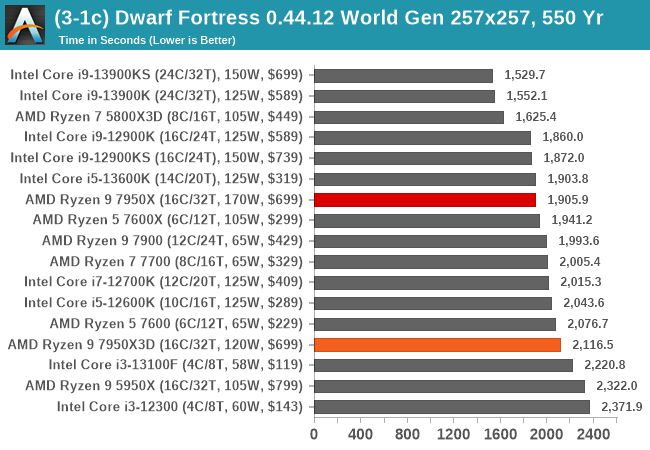

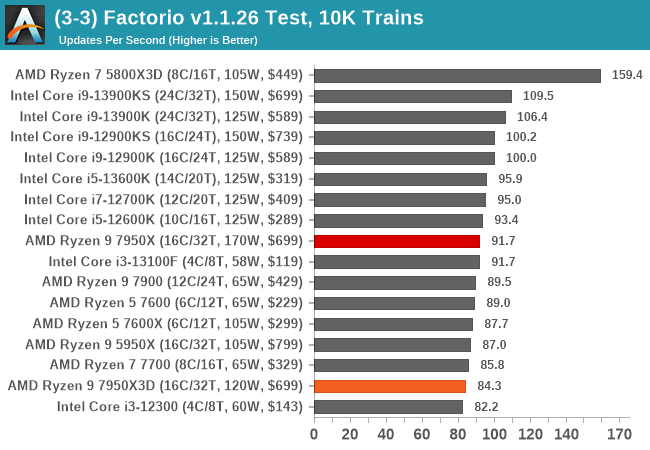

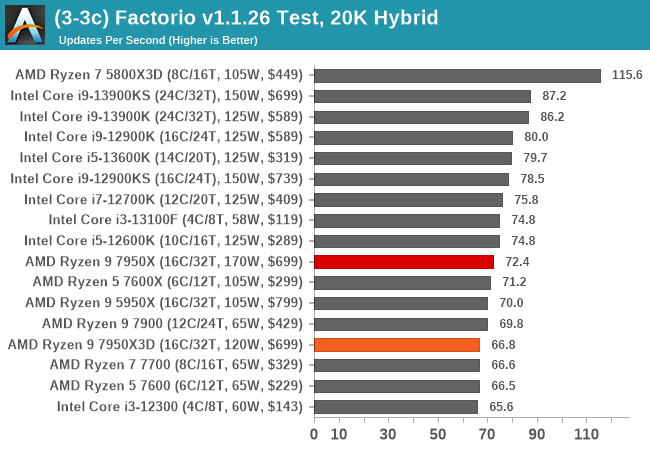
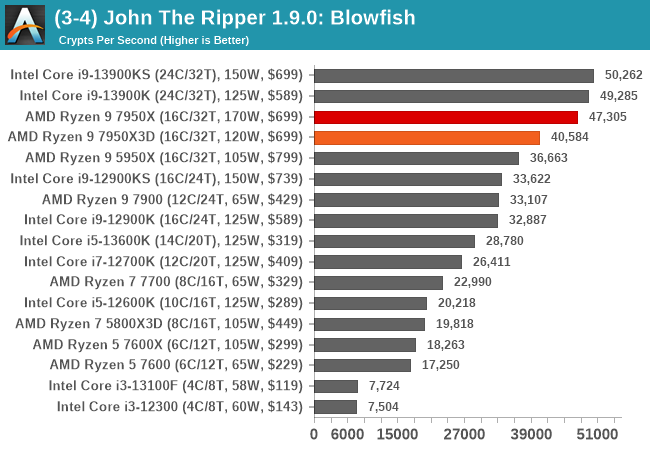
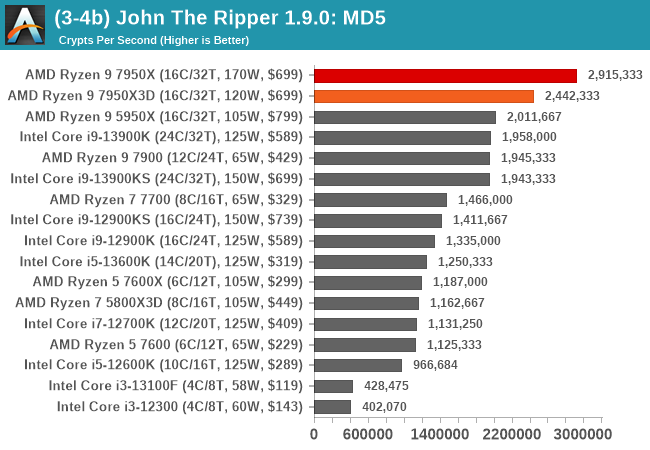
Looking at the results of our simulation-based tests, the Ryzen 9 7950X3D once again performs respectably across these tests. We would have expected higher performance in our Factorio benchmark, as the Ryzen 7 5800X3D and its 3D V-Cache did yield some impressive gains. This is likely due to the AMD PPM Provisioning and 3D V-Cache driver opting for frequency over cache when running this benchmark. That does show a little bit of a pitfall here for AMD.
Rendering tests, compared to others, are often a little more simple to digest and automate. All the tests put out some sort of score or time, usually in an obtainable way that makes it fairly easy to extract. These tests are some of the most strenuous in our list, due to the highly threaded nature of rendering and ray-tracing, and can draw a lot of power.
If a system is not properly configured to deal with the thermal requirements of the processor, the rendering benchmarks are where it would show most easily as the frequency drops over a sustained period of time. Most benchmarks in this case are re-run several times, and the key to this is having an appropriate idle/wait time between benchmarks to allow for temperatures to normalize from the last test.
One of the interesting elements of modern processors is encoding performance. This covers two main areas: encryption/decryption for secure data transfer, and video transcoding from one video format to another.
In the encrypt/decrypt scenario, how data is transferred and by what mechanism is pertinent to on-the-fly encryption of sensitive data – a process by which more modern devices are leaning to for software security.
We are using DDR5 memory on the Ryzen 9 7950X3D and the other Ryzen 7000 series we’ve tested. This also includes Intel’s 13th and 12th Gen processors. We tested the aforementioned platforms with the following settings:
- DDR5-5600B CL46 – Intel 13th Gen
- DDR5-5200 CL44 – Ryzen 7000
- DDR5-4800 (B) CL40 – Intel 12th Gen
All other CPUs such as Ryzen 5000 and 3000 were tested at the relevant JEDEC settings as per the processor’s individual memory support with DDR4.
Rendering
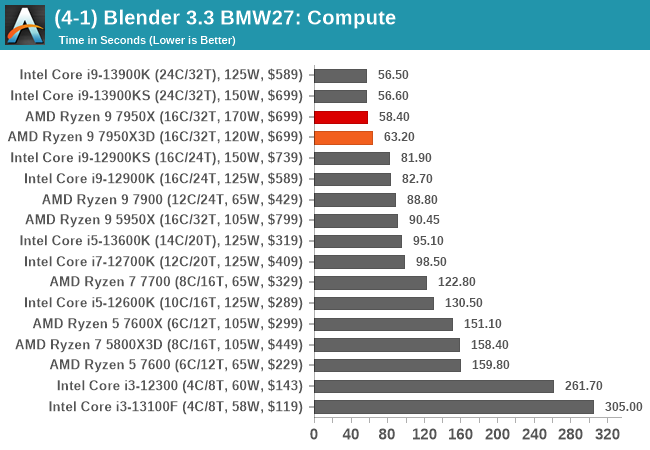
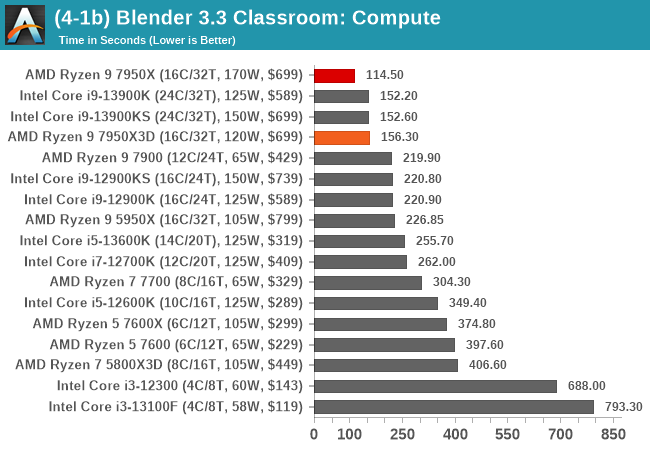
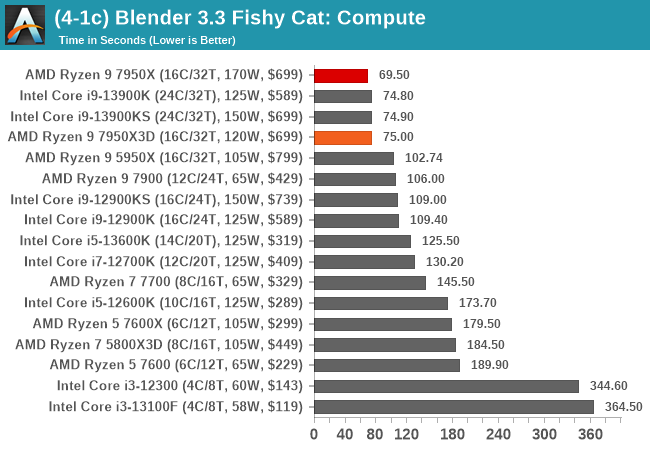
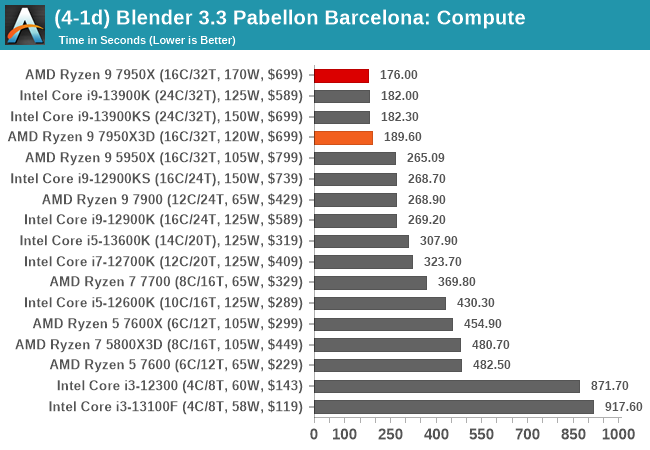
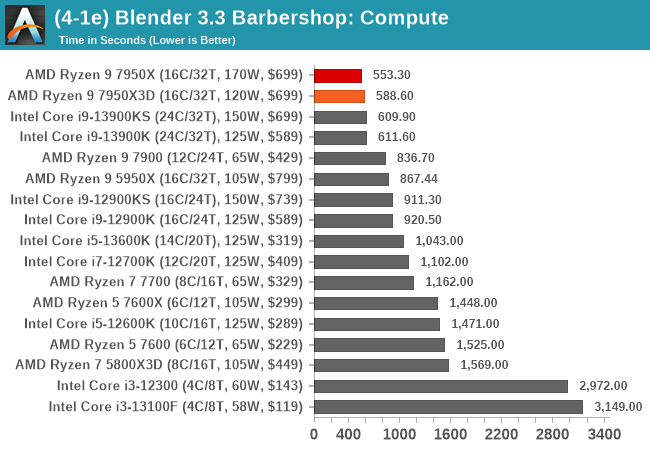
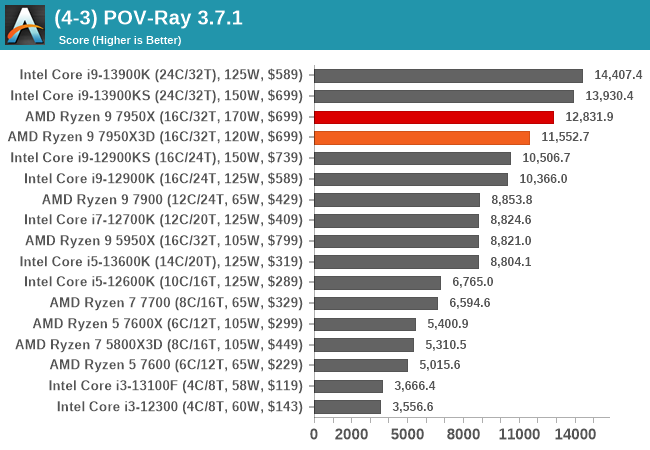
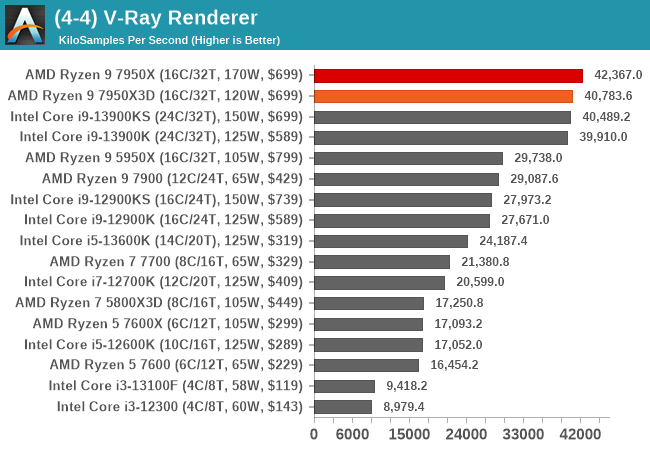
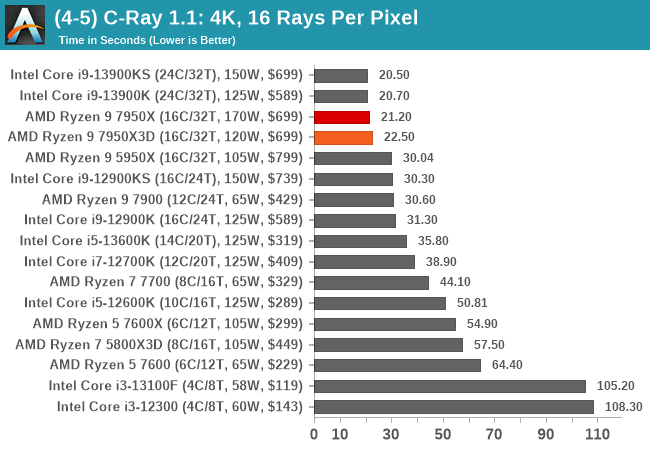

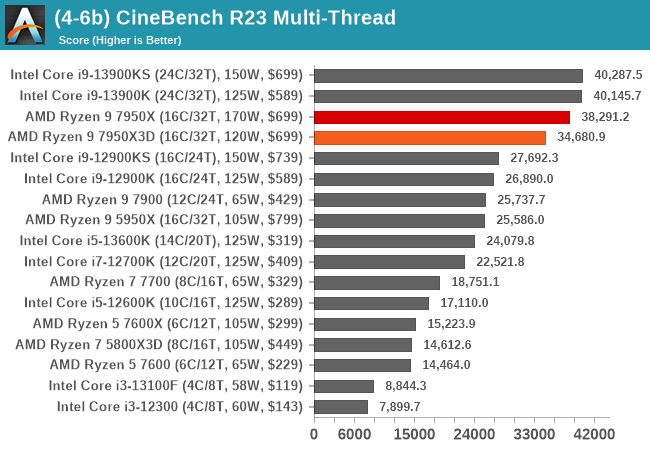
When it comes to rendering, the Ryzne 9 7950X3D doesn’t quite hit the compute performance of the Ryzen 9 7950X, but it isn’t too far off, given the discrepancies in power usage. It shows that the 7950X3D is more than capable of rendering workloads in an effective manner.
Encoding
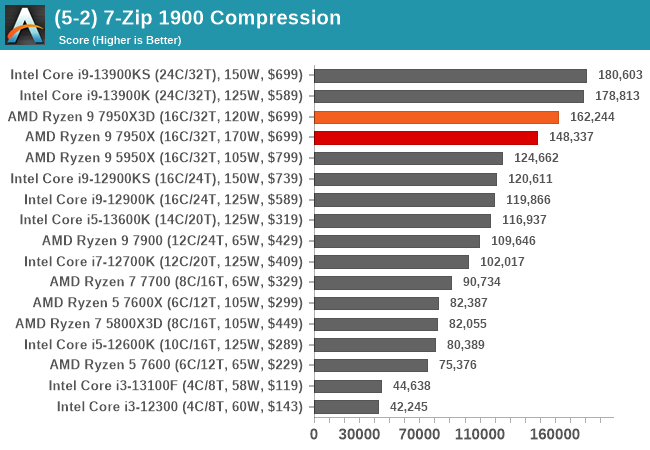

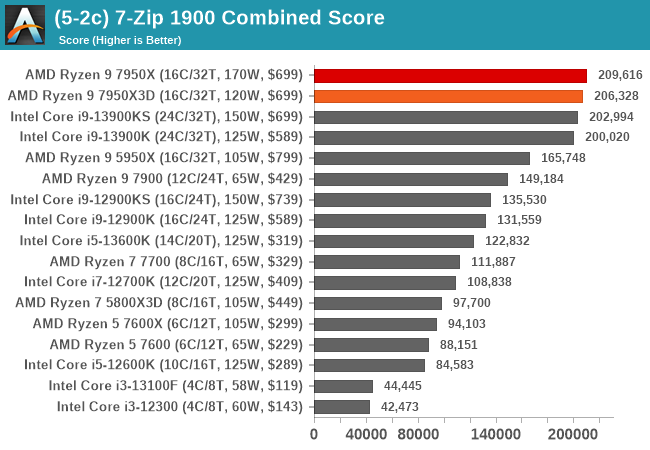
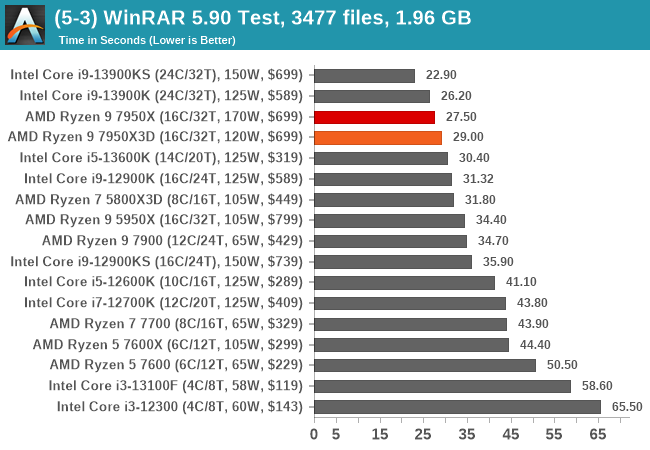
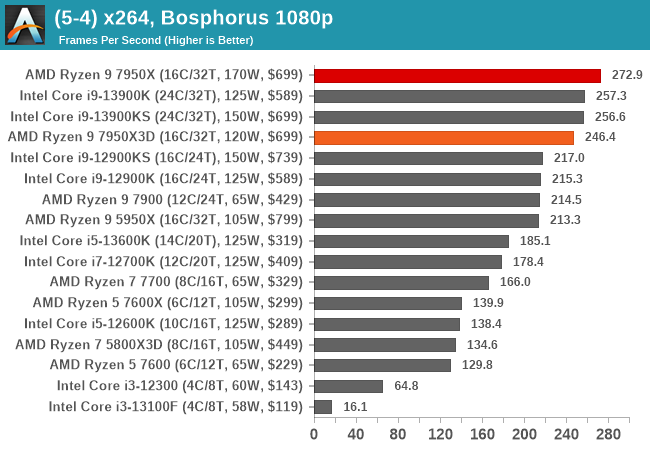
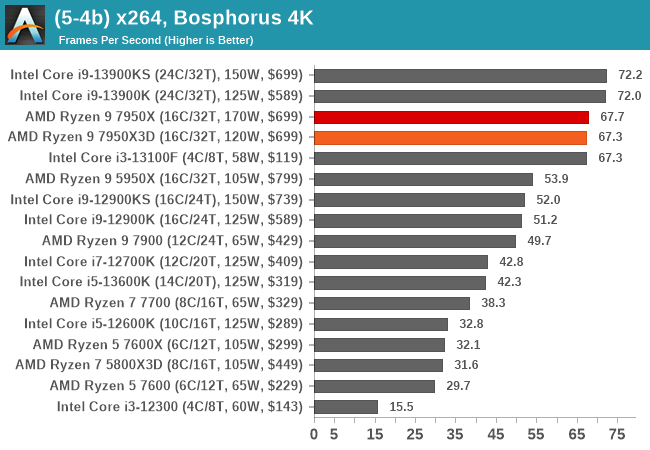
Our encoding section of the test suite is similar to other sections, where the 7950X is the faster and more power-hungry chip, which does output more performance. The Ryzen 9 7950X3D does however put in a respectable performance.
In order to gather data to compare with older benchmarks, we are still keeping a number of tests under our ‘legacy’ section. This includes all the former major versions of CineBench (R15, R11.5, R10) as well as Geekbench 4 and 5. We won’t be transferring the data over from the old testing into Bench, otherwise, it would be populated with 200 CPUs with only one data point, so it will fill up as we test more CPUs like the others.
We are using DDR5 memory on the Ryzen 9 7950X3D and the other Ryzen 7000 series we’ve tested. This also includes Intel’s 13th and 12th Gen processors. We tested the aforementioned platforms with the following settings:
- DDR5-5600B CL46 – Intel 13th Gen
- DDR5-5200 CL44 – Ryzen 7000
- DDR5-4800 (B) CL40 – Intel 12th Gen
All other CPUs such as Ryzen 5000 and 3000 were tested at the relevant JEDEC settings as per the processor’s individual memory support with DDR4.
Legacy
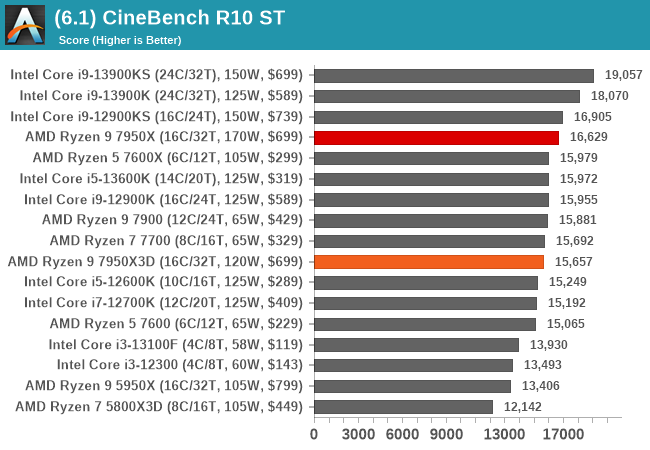
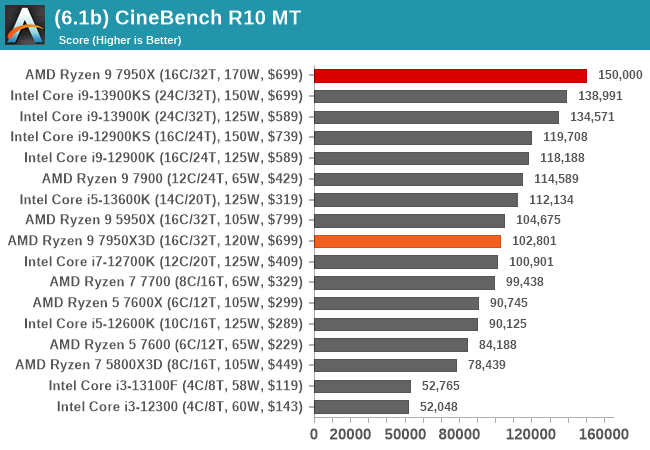


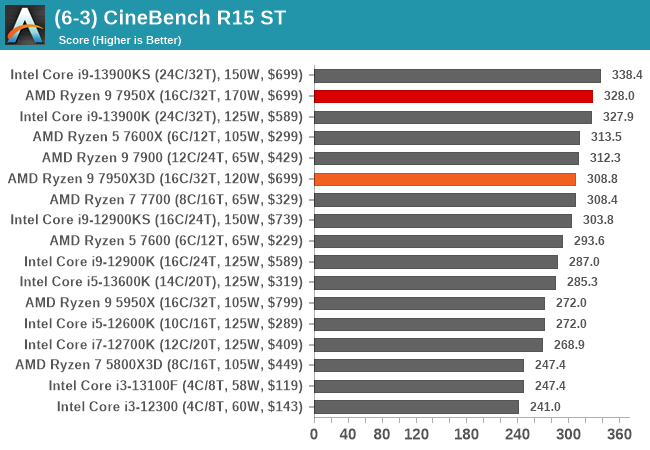

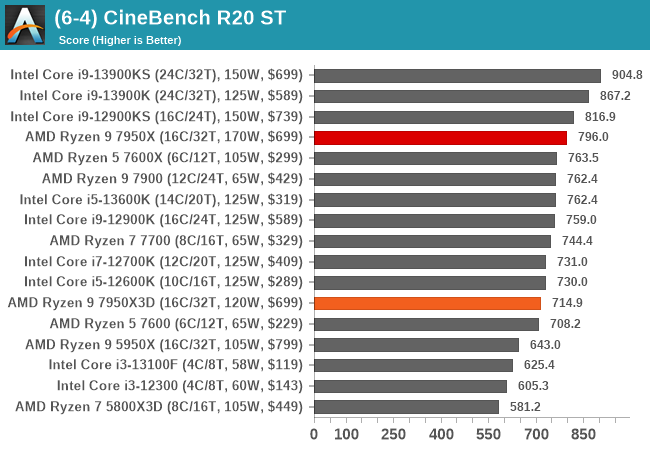
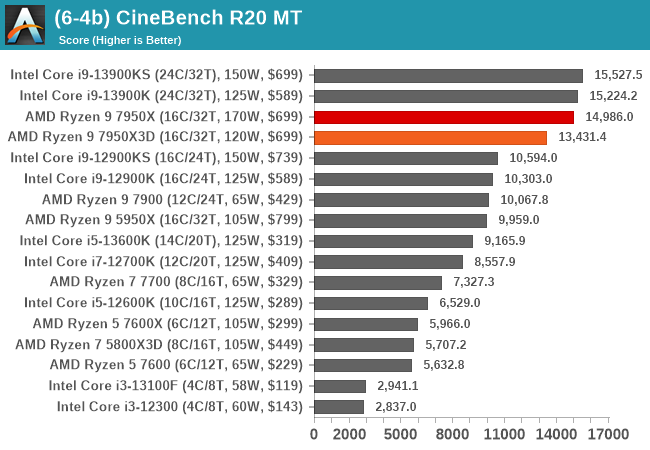

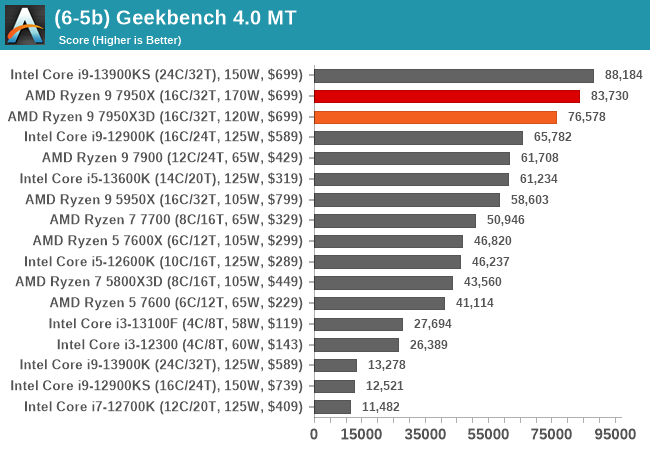
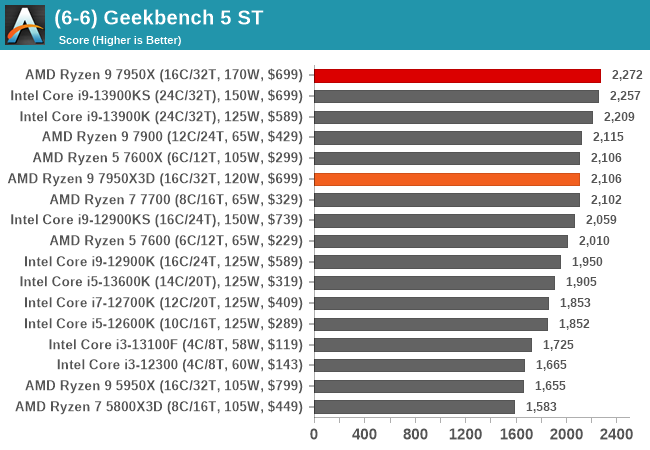
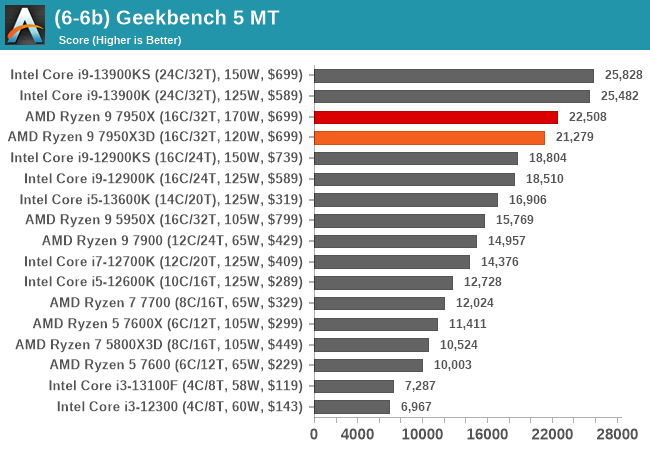
Our legacy testing is exactly what it says on the tin; tests featuring older benchmarks from previous iterations of our CPU suite. These legacy tests still provide a useful reference for where the performance is, even on older workloads. The Ryzen 9 7950X3D also does respectfully in these older benchmarks, albeit behind the Ryzne 9 7950X, which is to be expected.
The reason we test games in CPU reviews at lower resolutions such as 720p and below is simple; titles are more likely to be CPU bound than they are GPU bound at lower resolutions. This means there are more frames for the processor to process as opposed to the graphics card doing the majority of the heavy lifting.
There are some variances where some games will still use graphical power, but not as much CPU grunt at these smaller resolutions, and this is where we can show where CPU limitations lie in terms of gaming.
We are using DDR5 memory on the Ryzen 9 7950X3D and the other Ryzen 7000 series we’ve tested. This also includes Intel’s 13th and 12th Gen processors. We tested the aforementioned platforms with the following settings:
- DDR5-5600B CL46 – Intel 13th Gen
- DDR5-5200 CL44 – Ryzen 7000
- DDR5-4800 (B) CL40 – Intel 12th Gen
All other CPUs such as Ryzen 5000 and 3000 were tested at the relevant JEDEC settings as per the processor’s individual memory support with DDR4.
Civilization VI


World of Tanks
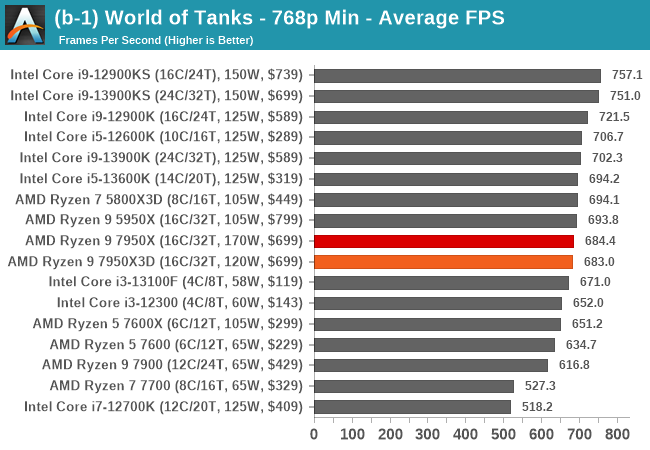
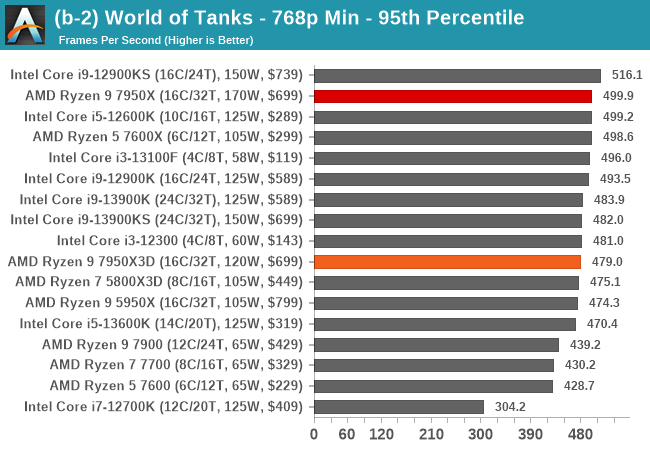
Borderlands 3

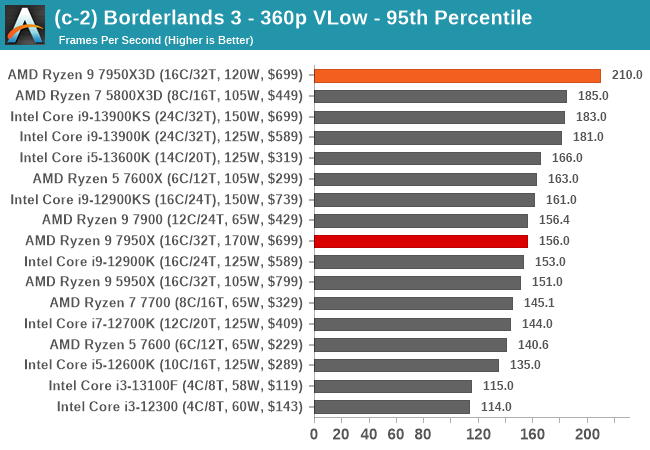
Grand Theft Auto V


Red Dead Redemption 2
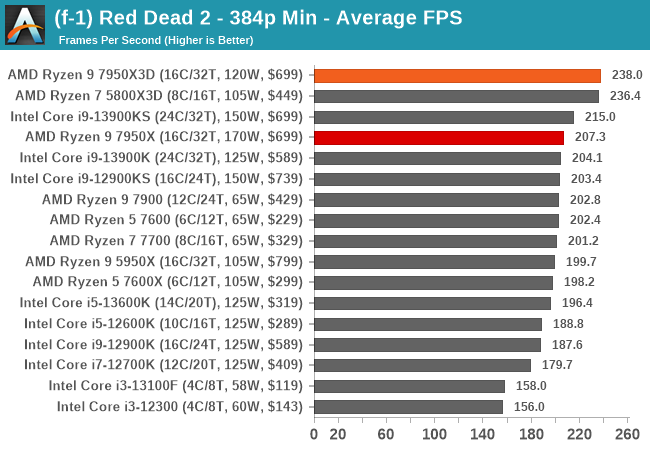
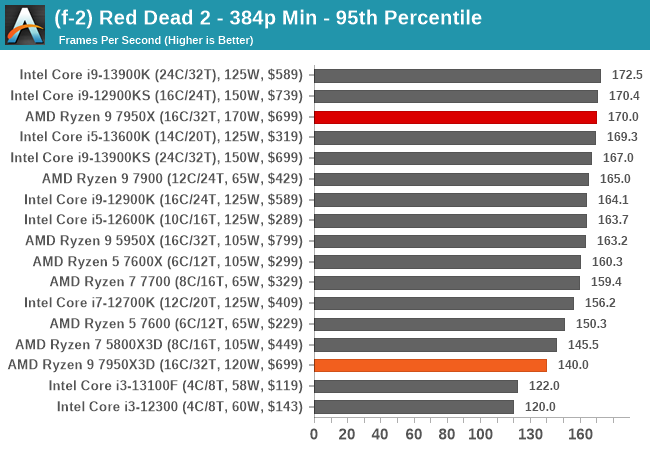
F1 2022
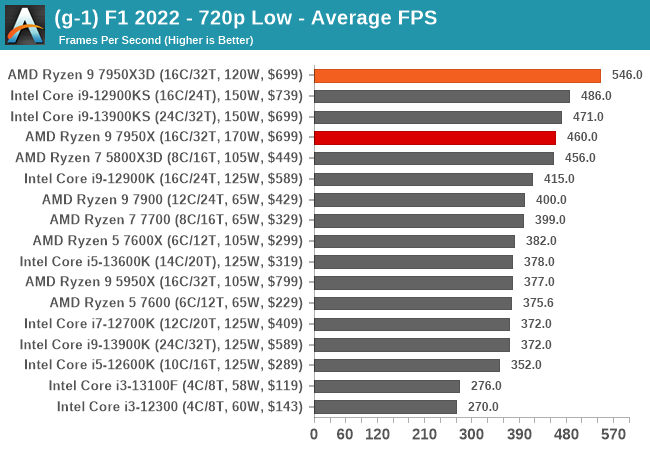

Hitman 3

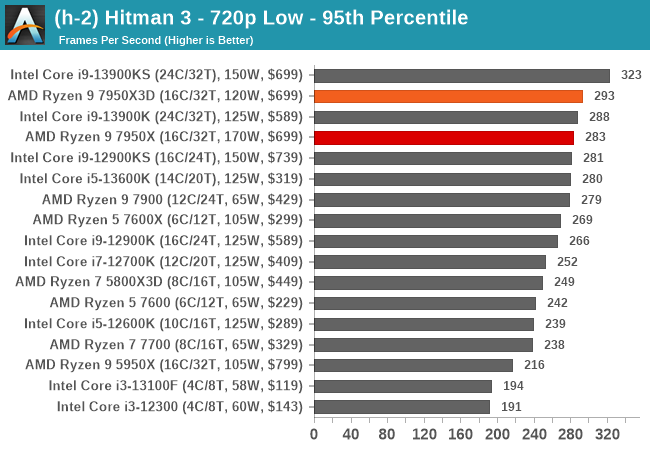
Total War: Warhammer 3
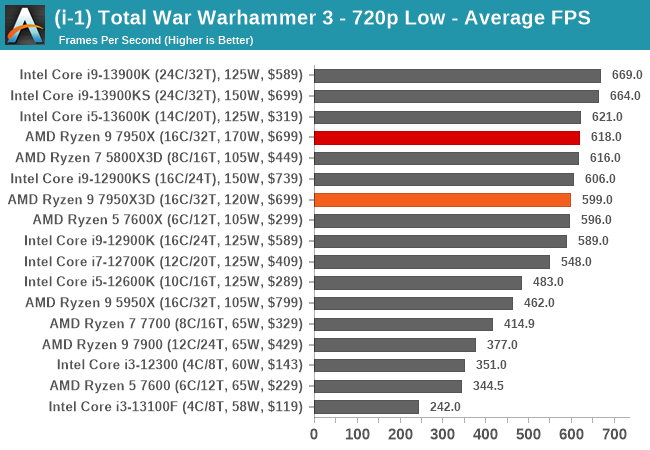
At lower resolutions, much of the slack and grunt work is done by the cores, and as we can see, the Ryzen 9 7950X does shine through here a little more in some titles with faster cores and more power available to them to deliver better low-resolution gaming performance.
The Ryzen 9 7950X3D does still do well, and where V-Cache can be helpful, titles such as Borderlands 3, Hitman, and F1 2022 do leverage the additional L3 cache to their advantage.
Moving along, here’s a look at a more balanced gaming scenario, running games at 1080p with maximum image quality.
We are using DDR5 memory on the Ryzen 9 7950X3D and the other Ryzen 7000 series we’ve tested. This also includes Intel’s 13th and 12th Gen processors. We tested the aforementioned platforms with the following settings:
- DDR5-5600B CL46 – Intel 13th Gen
- DDR5-5200 CL44 – Ryzen 7000
- DDR5-4800 (B) CL40 – Intel 12th Gen
All other CPUs such as Ryzen 5000 and 3000 were tested at the relevant JEDEC settings as per the processor’s individual memory support with DDR4.
Civilization VI
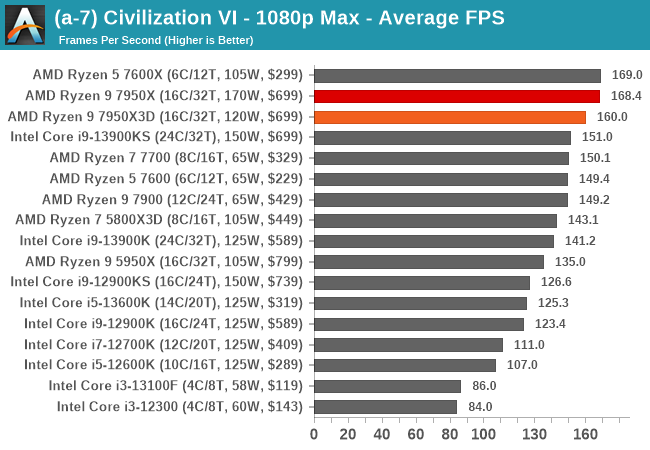
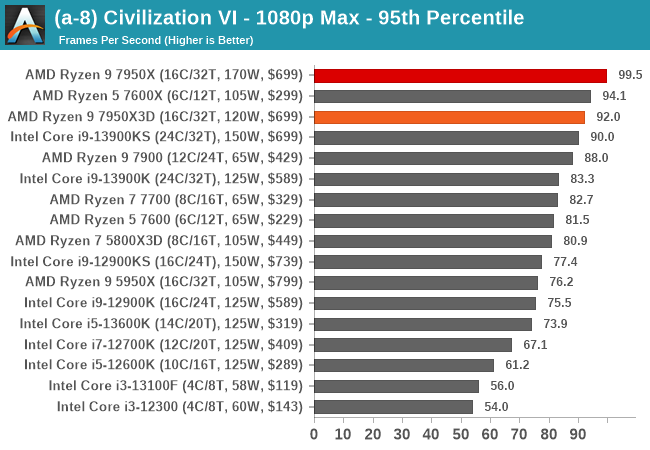
World of Tanks
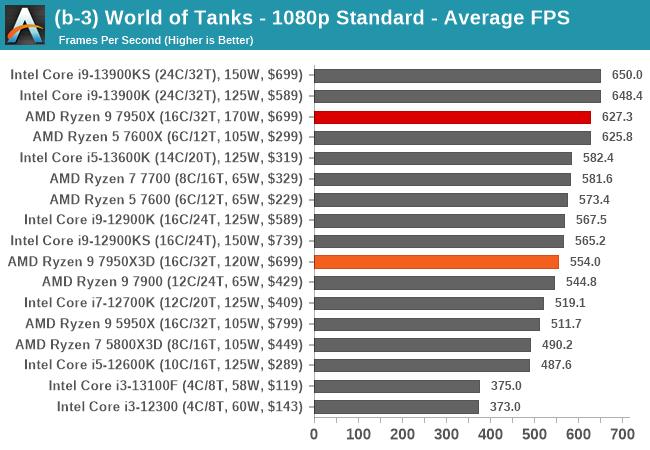

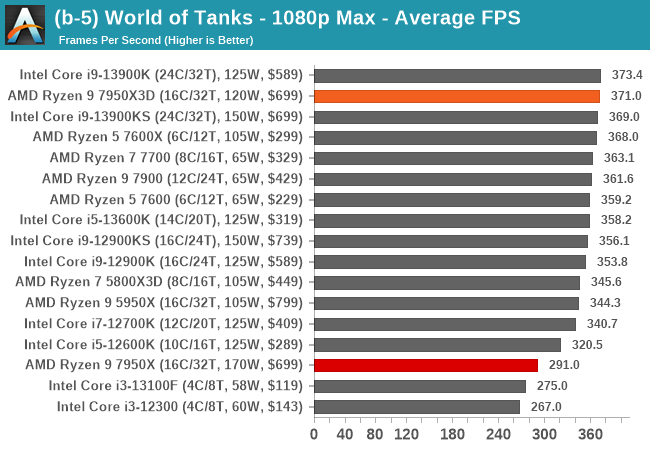
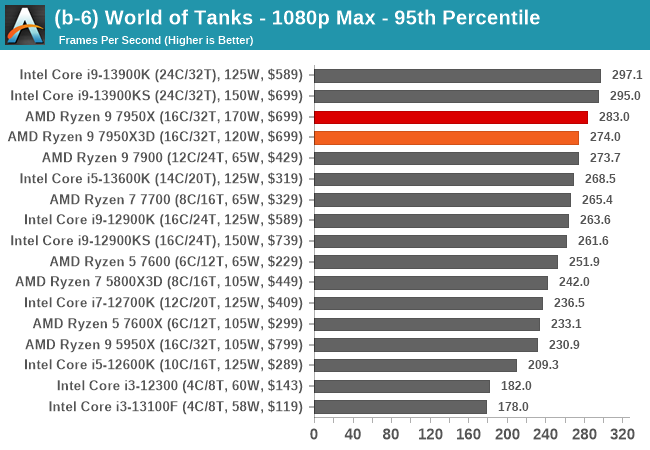
Borderlands 3
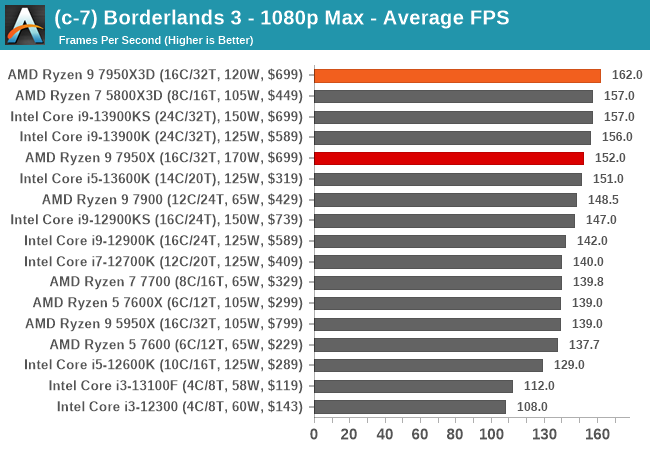
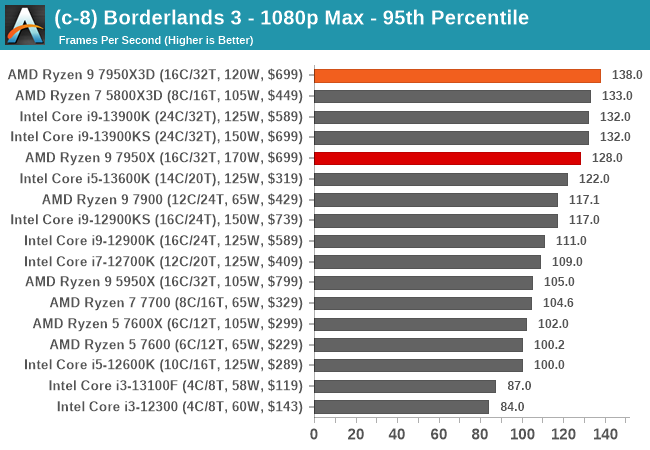
Grand Theft Auto V


Red Dead Redemption 2

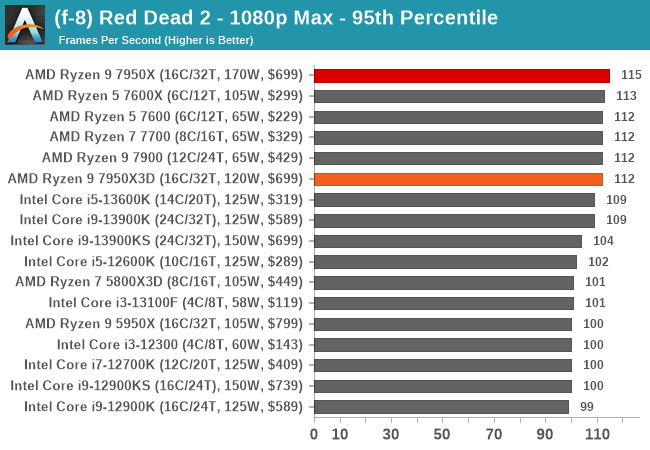
F1 2022

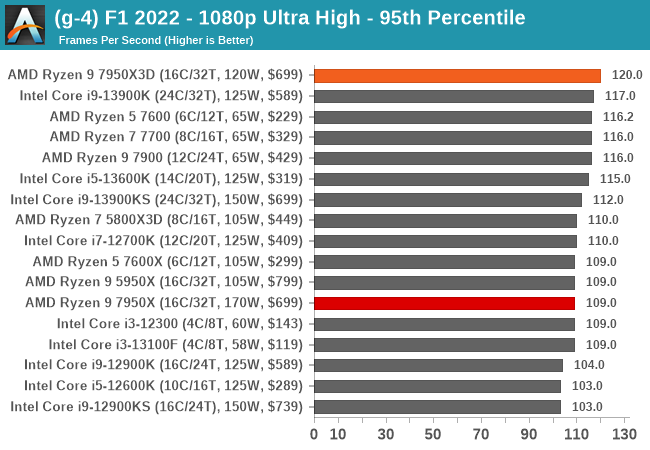
Hitman 3
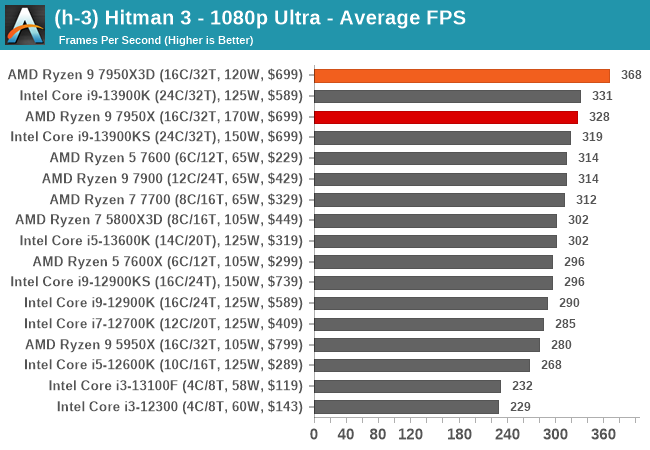
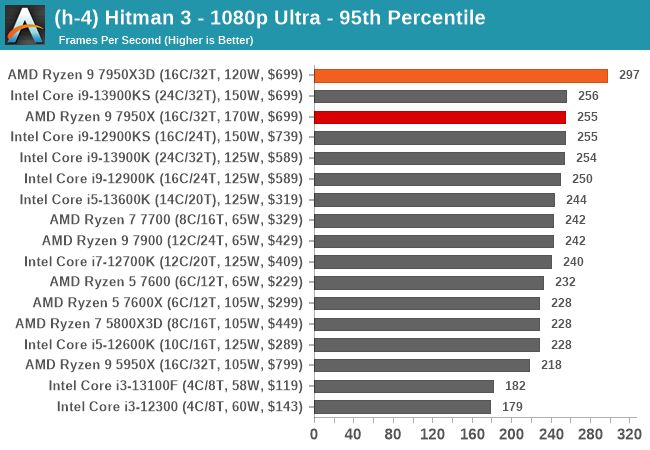
Total War: Warhammer 3
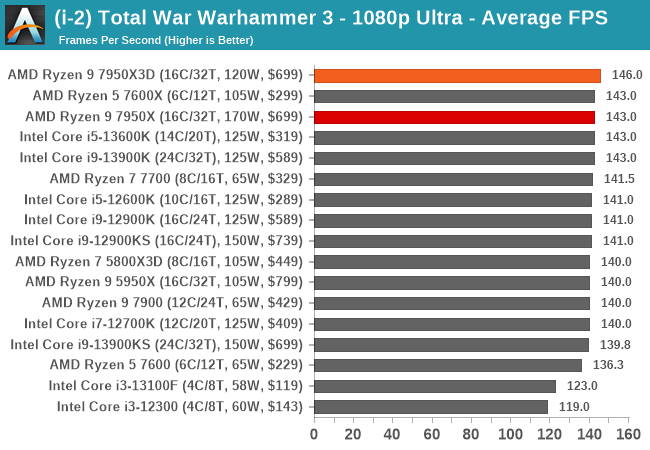
At 1080p, we’re seeing the 3D V-Cache on the Ryzen 9 7950X3D coming into play with more efficacy. In titles including Borderlands 3, Grand Theft Auto V, and Hitman 3, the 3D V-Cache offers an advantage over the other processors on test.
It should be reminded that when the AMD drivers are detecting a game, it’s using the CCX with the 3D V-Cache packaging, and not the other CCX. This essentially makes it an 8-core CPU with 96 MB of L3 cache, which is effective in some titles, and not so much in others where CPU frequency and core count matter.
In our Ryzen 7000 series review, we saw users commenting about testing games for CPU reviews at 1440p, so we have duly obliged here. Those interested in 1440p performance with minimal image quality – particularly the esports crowd – will be glad to know that we will be testing at this resolution going forward into 2023 and beyond.
We are using DDR5 memory on the Ryzen 9 7950X3D and the other Ryzen 7000 series we’ve tested. This also includes Intel’s 13th and 12th Gen processors. We tested the aforementioned platforms with the following settings:
- DDR5-5600B CL46 – Intel 13th Gen
- DDR5-5200 CL44 – Ryzen 7000
- DDR5-4800 (B) CL40 – Intel 12th Gen
All other CPUs such as Ryzen 5000 and 3000 were tested at the relevant JEDEC settings as per the processor’s individual memory support with DDR4.
Civilization VI
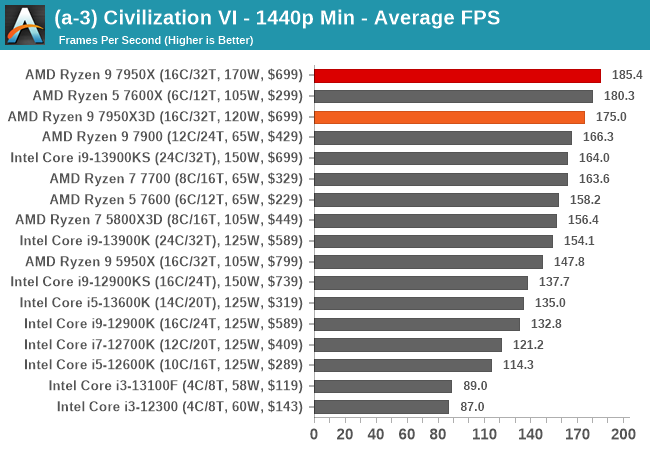

Borderlands 3
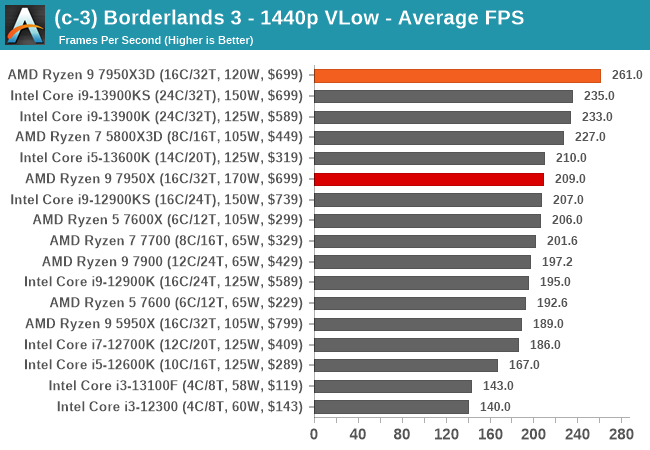

Grand Theft Auto V
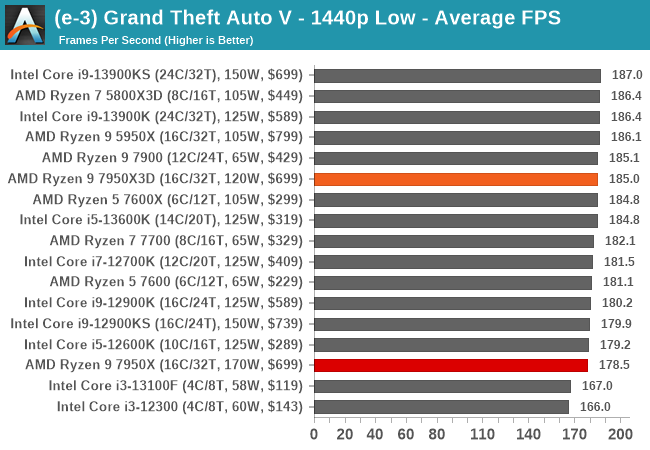
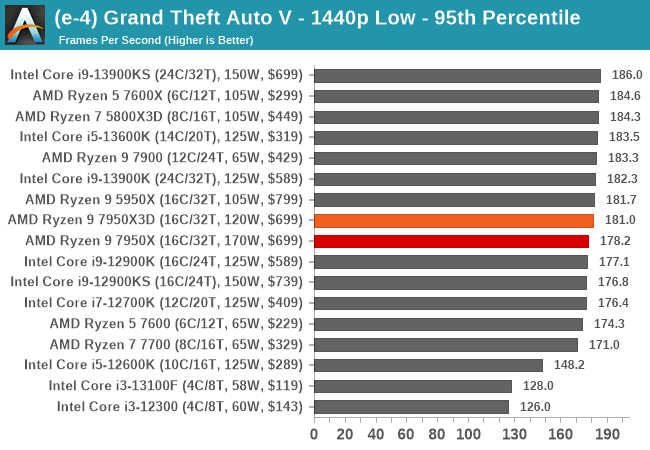
Red Dead Redemption 2
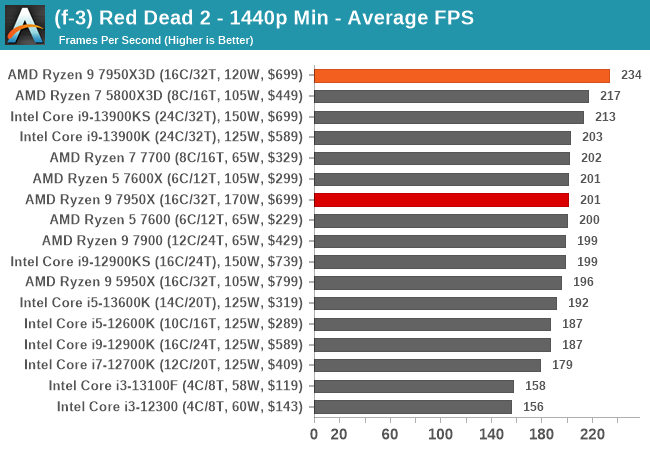
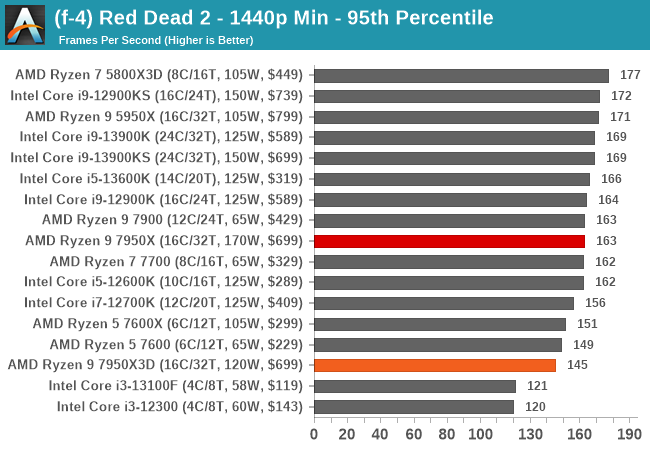
F1 2022

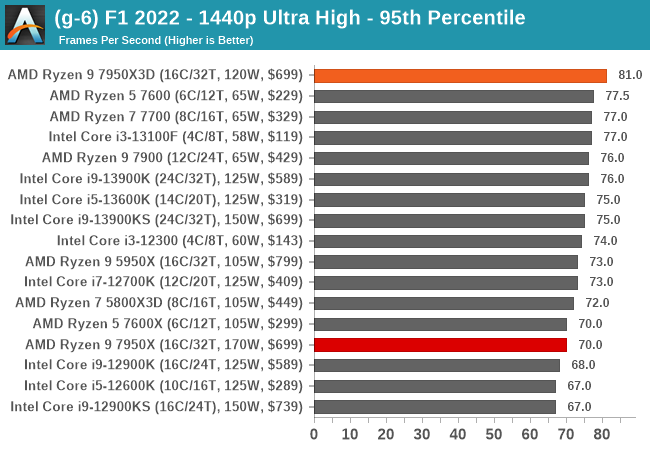
Hitman 3

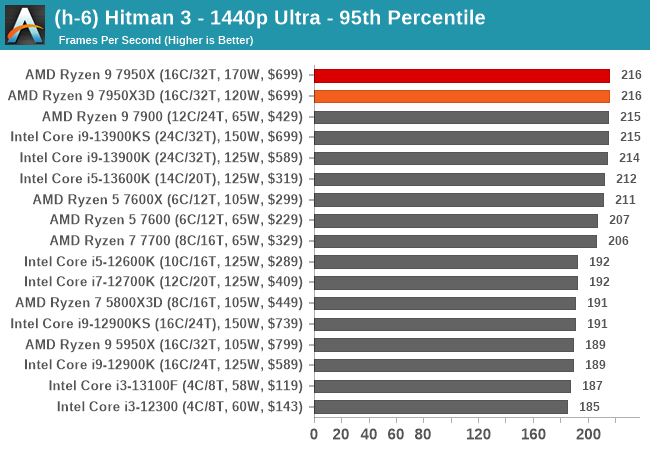
Total War: Warhammer 3
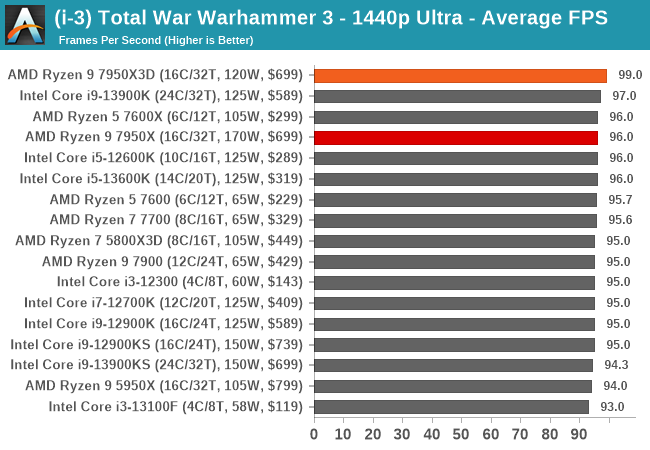
At 1440p, things become more GPU limited than CPU limited. In titles that can benefit from the large pool of L3 cache, the Ryzen 9 7950X3D does very well. The biggest win for the 7950X3D at 1440p is in Red Dead Redemption 2, where it is clear of the rest of the field convincingly in average frame rates, but it’s not as good as others in the 5% lows.
Overall, the Ryzen 9 7950X3D does well at 1440p, where the 3D V-Cache can be leveraged.
Last, we have our 4K gaming results.
We are using DDR5 memory on the Ryzen 9 7950X3D and the other Ryzen 7000 series we’ve tested. This also includes Intel’s 13th and 12th Gen processors. We tested the aforementioned platforms with the following settings:
- DDR5-5600B CL46 – Intel 13th Gen
- DDR5-5200 CL44 – Ryzen 7000
- DDR5-4800 (B) CL40 – Intel 12th Gen
All other CPUs such as Ryzen 5000 and 3000 were tested at the relevant JEDEC settings as per the processor’s individual memory support with DDR4.
Civilization VI
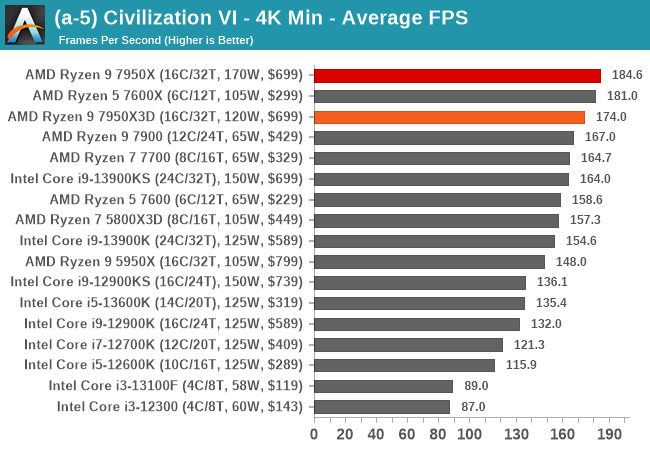

World of Tanks
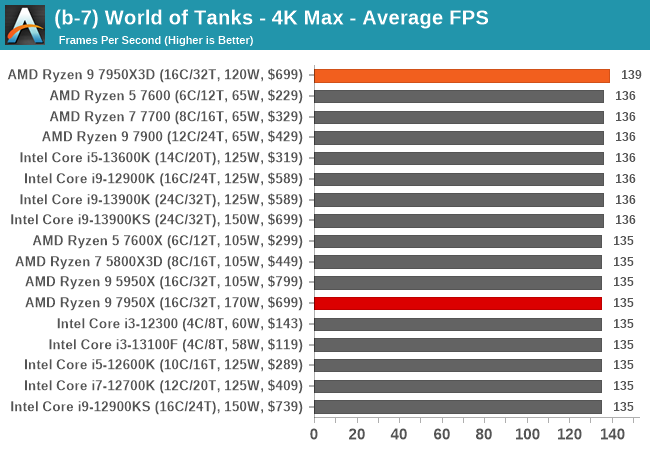
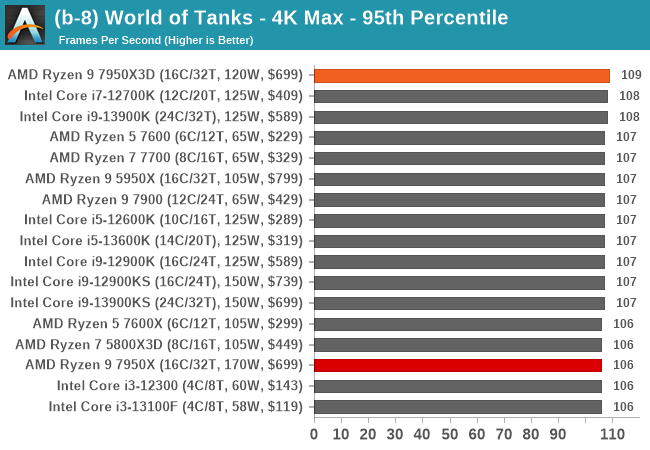
Borderlands 3

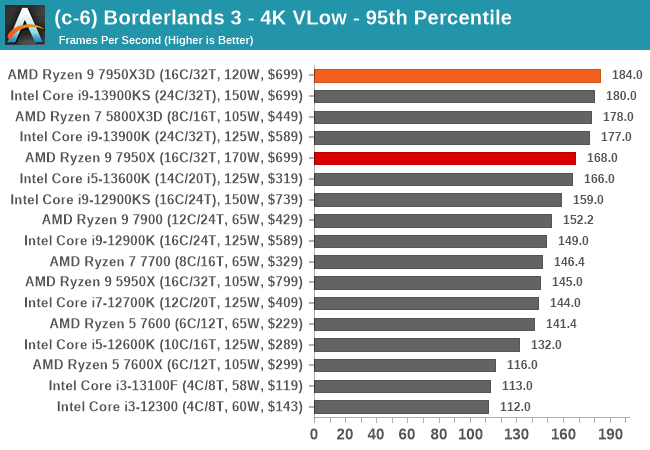
Grand Theft Auto V
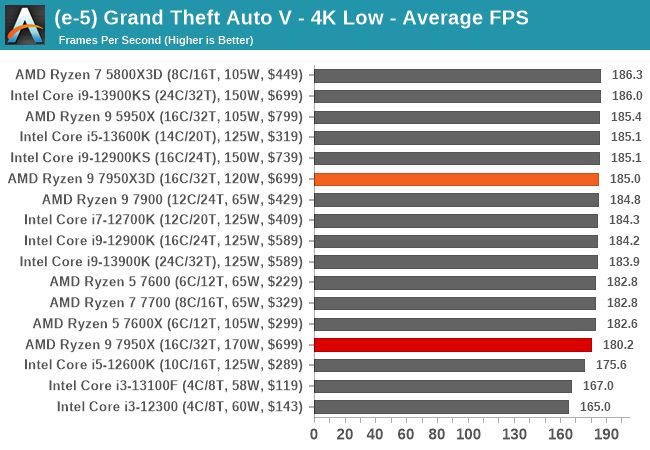

Red Dead Redemption 2
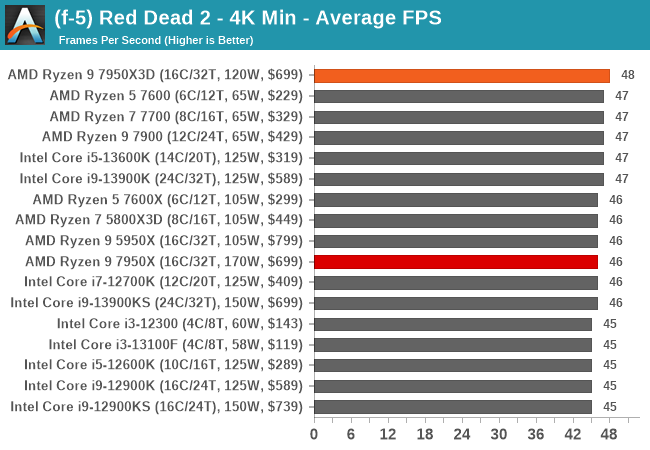

F1 2022
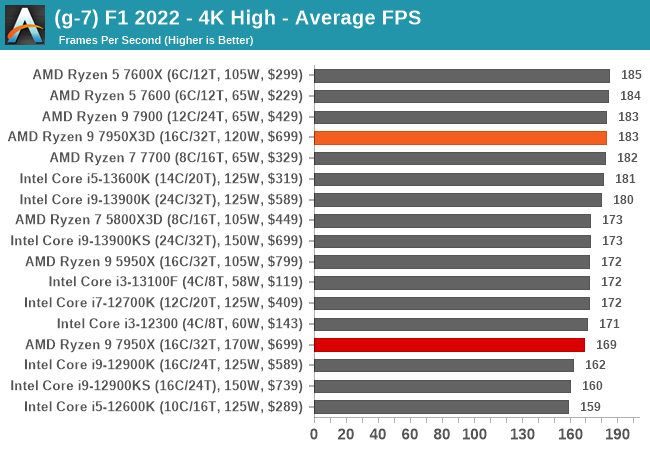
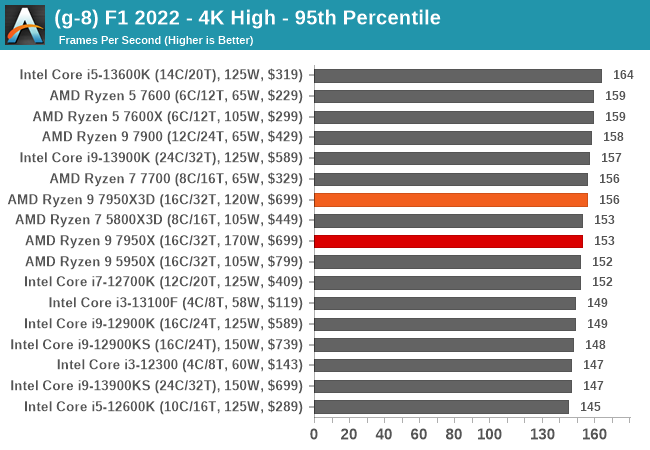
Hitman 3
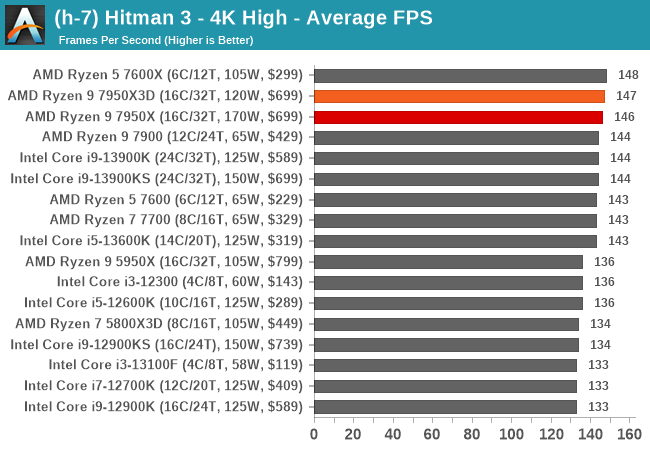
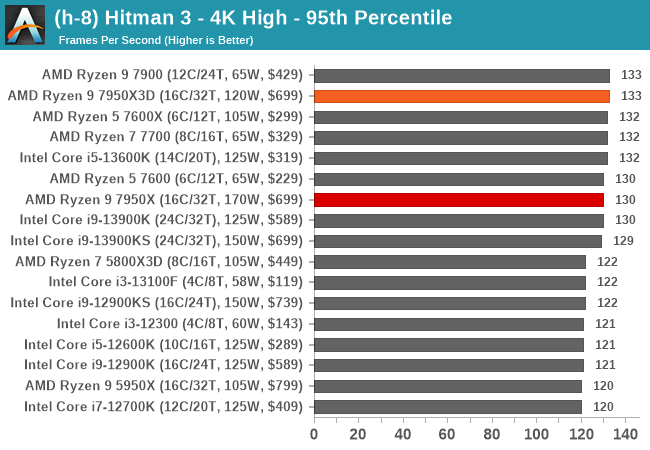
Total War: Warhammer 3
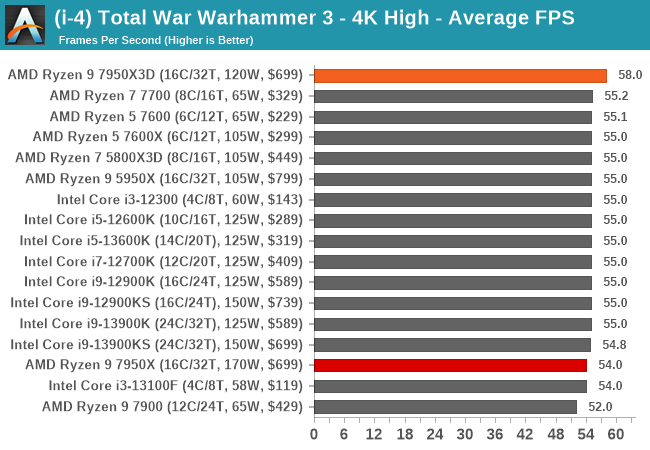
When it comes to 4K resolutions (3840×2160), things become very GPU limited. We did, however, see a couple of wins for the Ryzen 9 7950X3D, including in World of Tanks, Borderlands 3, and Red Dead Redemption 2; performance increases here are marginal, but a win is still a win. The biggest win was in Total War Warhammer 3.
When AMD unveiled its Ryzen 7 5800X3D with 96 MB of L3 cache, which was made possible with AMD’s 3D V-Cache chiplet packaging technology, it changed the game figuratively and literally. In games that can leverage that massive pool of L3 cache to their benefit, the 5800X3D looked like a superstar, but the only thing letting it down was the compute performance on offer. In those situations, it was worse than the existing Ryzen 7 5800X and cost $100 more. It was marketed and targeted at gamers and worked well, but that part was really only the first taste of what was to come – it was only a matter of time before AMD rolled out new X3D SKUs with the better-performing Zen 4 cores.

AMD Ryzen 9 7950X3D CPU-Z screenshot
Bringing their V-Cache technology forward to the latest generation of CPUs, AMD has much bigger plans this time around. Rather than only releasing a single part based on a mid-range chip design, AMD has put together a three chip stack that encompasses their flagship CPU configurations for the first time. The combination of AMD’s now well-proven Zen 4 CPU architecture and additional L3 cache makes for a potent partnership compared to AMD’s previous generational offering, with faster CPU cores and a new scheduling mechanisms to help Windows allocate threads on what is increasingly a non-homogenous CPU architecture.
AMD’s decision to build an asymmetrical CPU design makes for some interesting fodder for analysis. Parking CPU cores and altering core priorities on the fly adds a new layer to the onion that is OS thread scheduling, but it’s a necessary layer all the same for AMD to make the jack-of-all-trades type of chip that they set out to build. A homogenous chip using two V-Cache equipped CCDs would have been easier to work with, but it would have taken a bigger hit in compute performance, and likely more critically, it would have been even more expensive at time when consumers are already bristling at PC hardware costs.
In any case, with the flexibility of pretty fast cores for compute performance, and an 8-core CCD with 96 MB of L3 V-Cache that soaks up games, the Ryzen 9 7950X3D is a 16-core powerhouse that looks to provide gamers with more performance without asking them to give up too much compute performance in the process.
We saw different performance levels throughout as we put the Ryzen 9 7950X3D through its paces in our CPU suite. The AMD Ryzen 9 7950X3D will be hitting the streets tomorrow at $699, while the latter is currently available at the time of writing from Amazon for $589. This means the 7950X3D will be carrying a $110 premium over what has been AMD’s flagship chip for compute and gaming over the past 5 months.
For this review, we’ve analyzed the compute and gaming performance separately.
AMD Ryzen 9 7950X3D Gaming Analysis: 3D V-Cache Wins Again in Gaming, But Not in All Titles
When we reviewed the AMD Ryzen 5800X3D, we observed that some titles benefitted from the 3D V-Cache more than others; some of the titles in our suite weren’t impacted. And with the Ryzen 7000 family, that hasn’t changed – the benefits of the additional 64MB of L3 cache vary from title to title.
A quick summary of gaming performance highlights that games that can benefit from the 3D V-Cache perform very well. Some cases, such as Hitman 3, perform exceptionally better than the competition.

Looking at performance in Hitman 3 at 1080p Ultra settings, we can see that the Ryzen 9 7950X3D outperforms the Ryzen 9 7950X by around 12% in average frame rates. This is quite a jump in performance from just the L3 cache, and it plays into the hands of AMD here. While not all games on the market are optimized for processors with large cores, we can see that the Ryzen 9 7950X3D, when gaming, operates as an 8-core chip with 96 MB of L3 cache, outperforming the Ryzen 9 7950X with 16-cores and faster ones at that.

Another title where the 3D V-Cache boosts performance is Red Dead Redemption 2, one of the most popular open-world games. At 1440p minimum settings, we saw an increase of around 16% in average frame rates compared to the 7950X, which is very impressive. Concerning the Ryzen 7 5800X3D, which also showed solid performance levels, the Ryzen 9 7950X3D beat it by nearly 8%.

Perhaps the only caveat to the Ryzen 9 7950X3D in gaming came at the 95th percentile, which looks at the slowest 5% of frames. Where minimum frame rates and 5% lows are essential, the Ryzen 9 7950X3D saw 11% lower 95th percentile frame rates when compared to the 7950X. Taking our results in Red Dead Redemption 2 at 1440p as a prime example, we saw average frame rate gains over the 7950X by around 16%, but performance regressed by 12% at the 95th percentile.
Our suspicion here is that we’re seeing the lower clockspeeds of the V-Cache CCD rear its head. Bottlenecks shift during the frame generation process (AI, physics, world generation, etc), so where RDR2 benefits from the extra cache in some points, it may now be more compute bottlenecked in others. We did see examples with the Ryzen 7 5800X3D also displaying solid levels of average frame rate performance in some titles, but it was somewhat let down by 95th percentiles in some. The Ryzen 9 7950X3D is more consistent in 5% low performance, and although it wasn’t in every instance or every title, we did observe this in Red Dead Redemption 2 and World of Tanks. Like virtually everything else about the additional L3 cache, it’s all very situational.
Overall, the gaming performance on display from AMD’s Ryzen 9 7950X3D is undoubtedly impressive, and in titles where the 3D V-Cache can be leveraged, the 7950X3D is excellent. As you’d likely expect from hardware changes that improve the CPU, the biggest wins came at 1080p and 1440p resolutions, where the GPU is less likely to the bottleneck. And while 4K performance was still respectable, games are definitely more likely to be hard bound by GPU performance there. Much like the older Ryzen 7 5800X3D, the Ryzen 9 7950X3D is a chip primarily marketed for gamers, and from our testing, it’s undoubtedly a smart move from AMD.
As an aside, given just how situational the performance benefits are of AMD’s V-Cache, it would be nice to see AMD put together some sort of performance guide, even if it’s only on a semi-official basis. Having a list of games that see a performance benefit (and by how much) would be very helpful for buyers trying to decide on whether to splurge on the X3D chip, I believe. This is data AMD should already have in-house, especially as the GPU side of the business is already doing regular automated performance testing for new drivers.
AMD Ryzen 9 7950X3D Compute Analysis: Slightly Slower than the 7950X
Although the AMD Ryzen 9 7950X3D makes for a potent improvement in gaming workloads, there are far fewer examples of general computing workloads where the large amounts of L3 cache outweigh higher CPU frequencies. While AMD has narrowed the gap versus what we saw with last year’s single-CCD 5800X3D, the crux of the matter is the Ryzen 9 7950X3D still ends up being slower than the Ryzen 9 7950X in most computing tasks. While AMD’s drivers, optimizations, and CCX switching in games work well, for anything that can fire up more than 16 threads – enough work to spill over in to both CCDs – the clockspeed penalties from the V-Cache CCD and overall lower TDP inflict a price.

Taking examples from our CPU suite as a prime example that the Ryzen 9 7950X3D is slightly slower than the Ryzen 9 7950X in compute, we can see in the Blender 3.3 Fishy Cat (rendering) test that the Ryzen 9 7950X3D is around 7% slower than the Ryzen 9 7950X. This test put the Ryzen 9 7950X3D below the Intel Core i9-13900KS and 13900K, whereas the Zen 4 16 core goliath, the 7950X, does best. The Ryzen 9 7950X is a rendering beast, and although the Ryzen 9 7950X3D still performs well, the proof is in the pudding that users not too fussed about gaming are likely better off sticking with the architecturally homogenous (and very highly clocked) 7950X.

In encoding performance, and using our results in the x264 Bosphorus 1080p benchmark, we see much of the same again between the Ryzen 9 7950X3D and 7950X directly, as well as the positioning of the performance including the flagship 13th Gen Core i9-13900KS and 13900K processors. The Ryzen 9 7950X3D was a bit less than 10% slower than the Ryzen 9 7950X in this particular test, while it was only 4% slower than the Core i9-13900KS. I would still consider this a win for AMD, to an extent, as both chips will retail for similar prices, while the Ryzen 9 7950X3D offers more scope in gaming performance due to the inclusion of the 3D V-Cache.

Ultimately, the Ryzen 9 7950X3D still performs respectably in rendering, encoding, and other intensive workloads, but it’s clear that the Ryzen 9 7950X still holds the performance crown here for AMD. Given that the Ryzen 9 7950X3D at full load uses around 35% less power than the 7950X, this would always impact performance. Despite this, the Ryzen 9 7950X3D still performed well in our compute section, showing that Zen 4’s performance per watt efficiency is excellent. If anything, the 7950X is the outlier in this respect, as these results again underscore how AMD had to sacrifice a lot of that efficiency in the name of attaining all-out performance for their fastest parts.
AMD PPM Provisioning & 3D V-Cache Performance Optimizer Aren’t Always Right
Focusing on AMD’s new PPM Provisioning and 3D V-Cache Performance Optimizer drivers, we did come across an example where putting all the workload on both CCXs yielded the wrong outcome for performance. Technically an edge-case scenario, we found that AMD’s drivers and Microsoft’s Xbox Game Bar failed to detect that Factorio was running.

As we can see in our Factorio benchmark, we saw massive gains of over 100% when forcing the Ryzen 9 7950X3D to use the CCD with the 3D V-Cache as opposed to letting AMD’s PPM Provisioning and 3D V-Cache Optimizer drivers do their thing automatically. As Factorio is a proper game, this is one example where the drivers just didn’t make the best possible choice.
With that said, Factorio seems to be the one that got away for AMD. Otherwise, throughout our testing, we saw the AMD PPM and 3D V-Cache Performance Optimizer drivers working very well. So, while there’s clear room for improvement, AMD’s first foray into heterogeneous CPU cores is on the right track.

Users can force the Ryzen 9 7950X3D to use the 3D V-Cache in Xbox Game Bar.
For users who want to force the system to use the CCD with the 3D V-Cache, it can be enabled in the AMD Ryzen Master software, as well as within the firmware. Users can also circumvent the software by opening software or a game unfamiliar with the Xbox Game Bar and ticking the check box to tell the Game Bar that the active application is in fact a game.
Final Thoughts: The Ryzen 9 7950X3D is For Gamers, But It’s Still Respectable in Compute
AMD’s Ryzen 9 7950X3D is targeted more at gamers than content creators. What’s interesting about the new Ryzen 9 7950X3D when directly compared to the Ryzen 7 5800X3D is that the 7950X3D further enhances AMD’s 3D V-Cache chiplet packaging. The Ryzen 9 7950X3D benefits from 128 MB of 3D V-Cache (96 MB on one CCD) and has the latest Zen 4 cores based on TSMC’s 5 nm node, which has an IPC and frequency advantage over Zen 3.
Where the similarities end between the Ryzen 9 7950X3D and the Ryzen 7 5800X3D, the Ryzen 9 7950X3D does gaming excellently in titles that can leverage the 3D V-Cache, but it also has plenty of grunt from the 16-cores in compute tasks. Although we saw just one X3D SKU from AMD’s Ryzen 5000 generation, AMD is releasing three for Ryzen 7000.
The most expensive and perhaps best of these Ryzen 7000X3D SKUs is the Ryzen 9 7950X3D, which has an MSRP of $699, and although we haven’t reviewed the Ryzen 9 7900X3D, and the Ryzen 7 7800X3D doesn’t launch until April, the Ryzen 9 7950X3D should fare better than the others in compute performance. Regarding gaming performance, it’s hard to judge if the Ryzen 9 7950X3D will outperform the Ryzen 7 7800X3D when it launches.

AMD has cooked up an absolute gaming powerhouse with the Ryzen 9 7950X3D
This is because the Ryzen 7800X3D is an 8-core/16-thread part with 96 MB of 3D V-Cache on one CCD, while the Ryzen 9 7950X3D operates as an 8-core/16-thread part with 96 MB of 3D V-Cache when in ‘gaming mode. So, taking the above into account when factoring in gaming performance for the price, the Ryzen 9 7950X3D has an MSRP of $699, while AMD intends to launch the Ryzen 7 7800X3D for $449 on the 6th of April. Both of these chips should have similar levels of performance in many games, providing a quandary for users and gamers alike to decide.
For users looking for a solid all-around chip that can deliver leading gaming performance but still hang with the top dogs from Intel and AMD in compute performance, the Ryzen 9 7950X3D is an excellent offering. Even at $699, it represents a leading-edge offering with the latest Zen 4 cores packaged with AMD’s 3D V-Cache. It benefits gaming performance in specific use cases where the game can leverage a large level of L3 cache.
If you’re looking for the highest levels of compute performance for tasks such as video rendering and content creation, and it has to be Ryzen 7000, then the Ryzen 9 7950X still holds the overall performance crown. AMD has done a superb job with the Ryzen 9 7950X3D making it the fastest gaming processor in titles that can use the 3D V-Cache, while still offering decent performance in compute; that’s a win for AMD. AMD’s PPM Provisioning and 3D V-Cache Performance Optimizer drivers both work well and bolster the overall efficacy of the processor to deliver the right workload to the suitable CCD.
The Ryzen 9 7950X3D is still respectable, but if gaming isn’t your thing, then the Ryzen 9 7950X is currently cheaper than the 7950X3D at $589 from Amazon and still offers a good balance between gaming and compute performance. Otherwise, if gaming is your thing and you’re well informed that the titles you play the most can benefit from the 3D V-Cache, then the Ryzen 9 7950X3D is the way to go.
It could be worth waiting for the Ryzen 7 7800X3D if gaming is the only thing you do, as it’s around 55% cheaper (at MSRP) than the Ryzen 9 7950X3D and should, in theory, offer the same levels of gaming performance. It should also be noted that the Ryzen 7 5800X3D is currently on offer from Amazon for $323, representing excellent value for gamers.




